
Supersedes: CAPR 10-1 07 November 2016 OPR: CAP/DA
Distribution: National CAP website
CAPP 1-2
01 October 2021
The CAP Guide to
Effective Communication
NATIONAL HEADQUARTERS CIVIL AIR PATROL
Maxwell Air Force Base, Alabama

CAPP 1-2 01 October 2021
2
“This report, by its very length, defends itself
against the risk of being read.”
Winston Churchill
CAPP 1-2 01 October 2021
3
Table of Contents
Preface ........................................................................................................................................... 4
Overview ........................................................................................................................................ 4
Before You Get Started .................................................................................................................. 4
Branding ......................................................................................................................................... 6
We Need to Have a Meeting! ......................................................................................................... 7
Can We Talk? ................................................................................................................................ 10
Presentations ............................................................................................................................... 12
I Want To See That In Writing ...................................................................................................... 14
Getting A Head Start – Using Letterhead ................................................................................. 19
The Memorandum Style Letter ................................................................................................ 20
The Business Style Letter ......................................................................................................... 33
Electronic Communications ......................................................................................................... 39
Email ......................................................................................................................................... 39
Email Signature Block ............................................................................................................... 43
Social Media ............................................................................................................................. 43
CAP Publications .......................................................................................................................... 44
Directive Publications ............................................................................................................... 44
Nondirective Publications ........................................................................................................ 45
Forms, Certificates and Visual Aids…Oh My! ........................................................................... 45
I Need Approval?? The Secret to Good Staff Work ..................................................................... 46
Electronic Staff Summary Sheet (eSSS) .................................................................................... 48
Conclusion .................................................................................................................................... 53

CAPP 1-2 01 October 2021
4
PREFACE
This pamphlet complements Civil Air Patrol 1-series Regulations, as well as other publications.
It is designed to assist members in preparing Civil Air Patrol (CAP) publications and official
correspondence pertaining to CAP matters. This pamphlet also offers techniques for how to
conduct effective meetings and speaking engagements. Following the recommended
considerations, styles and techniques in this pamphlet promotes a consistently professional
look and sound of one CAP.
OVERVIEW
The effectiveness of any conversation is a direct result of the actions of both the speaker and
the listener. Likewise, the effectiveness of any document is often the direct result of the
actions of the person doing the writing. Regardless of whether the message is written or
spoken, the crucial point remains the same – the receiver must clearly understand the message.
The principles behind effective speaking are nearly identical to those of effective writing.
Therefore, most techniques and styles presented in this pamphlet are applicable to both
spoken and written communication.
BEFORE YOU GET STARTED
Below offers some general rules of thumb to consider when preparing for a speaking
engagement, including routine meetings, or written correspondence.
a. Put simply, you must know your intended audience. When speaking or writing, do so to
the audience’s level or to their shared understanding of the subject matter. Talking over
your audience’s heads is just as non-productive as talking beneath their level of
comprehension. The end result in both cases remains the same – you’ll lose your
audience’s attention.
b. Speak and write using plain language. Prepare all CAP correspondence and present
talking points using plain language. Plain language saves time, effort, and money while
improving the odds on your message being understood. Plain language means using
logical organization and common, everyday words, except for necessary technical terms.
For more plain language techniques, check http://www.plainlanguage.gov.
“I know that you believe you understand what you think I said, but I’m not
sure you realize that what you heard is not what I meant.”
Robert McCloskey
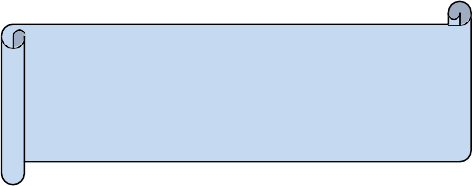
CAPP 1-2 01 October 2021
5
c. Speaking of using plain language, use a spelling and grammar checker too. Most word
processing and email programs include them. You can configure them to work
automatically which could save you much embarrassment down the road. Let’s face it;
the last thing you want is to spend time crafting a professional letter only to have it sent
containing typos and poor grammar.
d. Organize your material to help the reader/listener. Identify your audience for the
document; write or speak to get their attention and anticipate their questions. Always
start by putting your main message up front. Present information in subsequent
paragraphs/slides in a logical order. See the section on Presentations for more
information.
e. Keep in mind that in today’s electronic age your correspondence or recordings of
presentations, such as webinars, may be shared around the globe via the internet, with
or without your consent. Internet search engines find everything! As such, keep it
professional and consider that your correspondence may be referenced in other
documents and viewed by unknown audiences.
f. Structure your communication
with your audience in mind.
Consider that your audience may
not be familiar with some
abbreviations, may not share your
technical expertise on a subject or
just may have a limited background on your topic. Define each abbreviation or acronym
the first time used by writing out the full term followed by the abbreviation or acronym
in parentheses. Use the same term consistently to identify a specific thought or object.
Use words in a way that does not conflict with ordinary or accepted usage. Ambiguous
phrasing, confusing legal terms and technical jargon could mislead your reader.
Similarly, using military or CAP jargon rather than common terminology may confuse
your audience. However, if you believe your audience shares a common understanding
of the jargon, its use might foster a better conversation.
g. A picture is indeed worth a thousand words. Pictures and tables, when used properly,
can replace paragraphs or even pages of text. Most people learn visually or through
application and practice. Using graphics in presentations speeds learning and
comprehension.
h. Use “you” and other pronouns to speak directly to your audience (active voice).
Referring to people as if they were inanimate objects may be offensive. “You”
reinforces that the message is intended for your audience. Use “we” in place of your
organization’s name. Be careful using “you” if it sounds accusatory or insulting. Instead,
put the emphasis on the organization by using “we.”
“It usually takes me more than three
weeks to prepare a good impromptu
speech.”
Mark Twain

CAPP 1-2 01 October 2021
6
i. Active voice is the best way to identify who is responsible for what action. To
communicate effectively, write or speak the majority (around 75%) of your sentences in
the active voice. Keep in mind that some people are uncomfortable with the direct
approach of active voice. Again, know your audience, but remain aware of the intent
and tone of your message; passive voice might not be effective when directing actions.
j. Short sentences deliver a clearer message. Your sentences should average less than 20
words; never make them longer than 40 words. Complex
“I never said most of
the things I said.”
Yogi Berra
sentences confuse your audience by losing the main point
in a forest of words. Resist the temptation to put
everything into one sentence. Break up your idea into its
logical parts and make each one the subject of its own
sentence. Cut out words that are not really necessary.
k. Never overlook the value of good guidance. There are countless resources to help you
prepare for your writing or speaking task. Air Force Handbook 33-337, The Tongue and
Quill, available on the CAP publications website under other publications, is one such
resource that offers techniques and styles for both writing and speaking engagements.
Another free resource is the Air University Style and Author Guide. Also talk with others
who might share experiences in performing what you’re being asked to do.
Additionally, there is tremendous value in dry-running your presentation with peers or
letting others read your correspondence prior to sending. Since we often use voice
inflection in reading an email or letter to your test audience, it’s best to let them read
the draft email or letter in silence to see if the reader receives the message with the
same intent you desired.
l. Finally, if you’re writing or speaking on matters pertaining to CAP, your language should
leave the recipient with a positive view of CAP. Nearly just as important is the fact that
the medium you use to share your information, such as a memorandum, presentation
or web page, should reinforce a consistent look, sound, and feel of One CAP. In short,
authors should follow CAP’s established branding standards.
BRANDING.
In the corporate world, branding is essential to developing and growing a strong customer base.
Due to the broad reach of electronic communications, branding is critical to ensuring
that all recipients and online
“Great companies that build an enduring brand have
an emotional relationship with customers that has no
barrier. And that emotional relationship is on the
most important characteristic, which is trust.”
Howard Schultz
viewers receive the same look,
sound and feel of One CAP. As a
corporation, CAP relies on
branding to ensure its customers
readily recognize CAP for the
quality services provided.
Branding is the process of
creating a unique name and image and plants this image in customer’s minds to establish
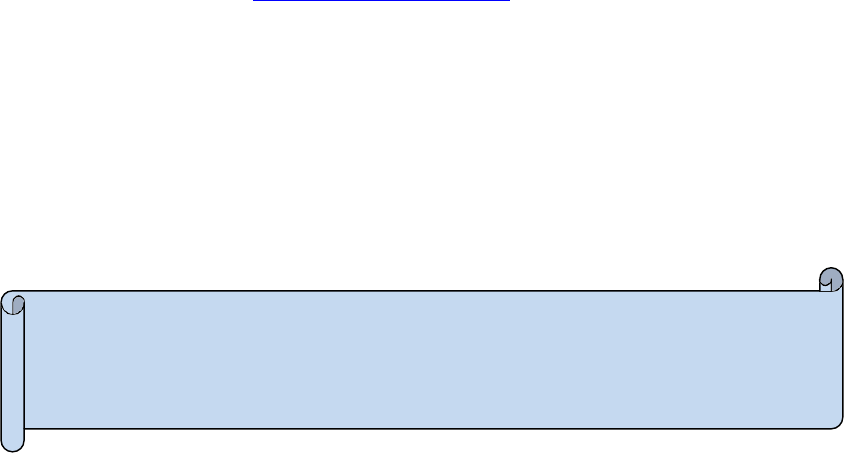
CAPP 1-2 01 October 2021
7
brand identity. This identity is created mainly through a consistent theme that includes, but not
limited to, the use of a single CAP logo and standardized appearance of CAP’s web pages, email
signature blocks, and business cards. The goal is to make CAP a household name with
immediate recognition of a nationwide CAP. For more information on CAP’s branding program,
refer to CAP’s Brand Portal at brand.gocivilairpatrol.com.
WE NEED TO HAVE A MEETING!
How many times have you heard “We need to have a meeting to schedule a meeting” or “Boy,
that’s an hour of my life I’ll never get back”? The truth of the matter is we’ve become a society
where meetings are the norm for the so-called conducting of business and, sadly, too many
meetings occur that are unproductive. If time truly is money, then meetings need to be
productive, mean something, and involve the right people.
There is some value to holding meetings.
a. Meetings create an opportunity for dialogue, especially when the decision maker needs
immediate input and feedback. Yes, contributors can provide input via emails, but
emails are essentially a series of one-way conversations and lengthen the decision-
making process.
b. Meetings increase awareness for all participants and promote sharing of information
and ideas across unrelated areas of expertise. The assumption, of course, is made that
the meeting is keeping the attendees’ interest, otherwise the daydreaming will begin.
c. Meetings also enable the communicating of a message from one to many at the same
time while providing clarity through question and answer. Such meetings get everyone
on the same page. Let’s face it, there’s nothing better than hearing it straight from the
horse’s . . . oops . . . commander’s mouth.
d. There’s also value in recurring meetings to present routine or mandatory updates. The
key, as always, is to make the meeting productive.
e. Finally, meetings can build camaraderie amongst colleagues. There’s no rule that states
meetings must be stuffy or boring!
“If you had to identify, in one word, the reason why the human race has not
achieved, and never will achieve, its full potential, that word would be
‘meetings’.”
Dave Barry

CAPP 1-2 01 October 2021
8
There are several downsides to ill-planned meetings.
a. First, meetings aren’t always needed. If the purpose is to simply share information, then
perhaps an email or document is a better way to get the message to the masses and
certainly a better use of their time.
b. Meetings can have unintended consequences. Sometimes commanders will make an
innocent comment that someone interprets as a “go do” task. Commanders should be
deliberate in tasking attendees. Furthermore, attendees should seek clarification on the
perceived task before they “go do.” Otherwise, there might be needless and wasted
effort.
c. Meetings serve to communicate information to those in attendance, with an
expectation that those in attendance will further disseminate the message. In reality,
this seldom happens as expected. The geographically separated nature of CAP greatly
complicates the effective sharing of information.
d. If not properly planned, the meeting will not serve its intended purpose. When that happens,
invariably another meeting will be scheduled. Save everyone’s time and prepare for a productive
meeting.
e. Meetings, like committees, have group dynamics. Having the wrong players at the table
could take the meeting off course. The person running the meeting should set the
boundaries and keep attendees focused on the matter at hand. Additionally, be alert
for groupthink, the phenomenon that occurs within a group of people in which the
desire for harmony or conformity in the group results in an irrational or dysfunctional
decision-making outcome.
“I don’t like to spend time in endless meetings talking about stuff that isn’t
going to get anything done. I have meetings, but they’re short, prompt
and to the point.”
Eli Broad
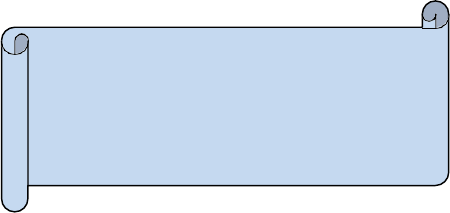
CAPP 1-2 01 October 2021
9
Keys to a successful and productive meeting:
a. It’s imperative that the right people are in attendance. Don’t hold a decision-making
meeting if the decision maker or subject matter experts are not present.
b. Define the purpose of the meeting and determine if a meeting is the best approach.
You would think it obvious that every meeting has a purpose, but sometimes people
habitually go through the motions. If a meeting is not needed – don’t hold one.
c. Pick a time and location that’s conducive to a productive meeting. Again, the
geographically separated nature of
CAP and the crossing of time zones
present challenges, but the use of
teleconferencing and online
applications such as webinars can
enable productive meetings.
“We had some very distinguished fans:
I know one chancellor of a major
university who used to schedule his
meetings around Star Trek.”
Patrick Stewart
d. Determine the best medium for conducting the meeting when members cannot be in
the same room. Teleconferencing is inexpensive, but members don’t get the luxury of
placing faces to names or voices. Video conferencing and webinars provide such a
luxury. Sites such as gotomeeting.com, gotowebinar.com, zoom.us and
hangouts.google.com are rather inexpensive and sometimes free to use. Regardless of
the medium, the individual running the meeting should remind attendees of the
following general rules of etiquette:
• State your name prior to speaking. This is more important for conference calls
where video is not an option.
• If you’re not speaking, mute the phone/microphone on your end. You are
participating in the meeting, not your barking dog.
• For video conferences, consider your backdrop for possible distractions. Yes,
you might have something important to contribute to the meeting, but other
attendees aren’t listening because they’re watching the ball game on the TV
behind you.
• Likewise for video conferences, just because you’re joining from your home
office doesn’t mean you can wear your pajamas. Dress appropriately. Keep in

CAPP 1-2 01 October 2021
10
mind that it’s quite easy to record online meetings and share with your closest
friends.
e. Appoint someone to record or take minutes of the meeting. The last thing you want is
for important information to be discussed or decisions to be made and nobody
remembers who said what and why. Keep in mind that meeting minutes are not play-
by-play transcripts; rather they serve to highlight the key points that were discussed.
f. Send out an agenda. It is preferable to send the agenda one week in advance of the
meeting; anything less than two days jeopardizes the meeting’s productivity. The
agenda lets attendees know the issues to be addressed, decisions to be made and
actions to be taken. Plus, the agenda lets attendees know what data to bring with them
to aid the decision-making process. Additionally, providing hard copies of the agenda
makes it easier for attendees to take notes.
g. Send out read ahead material. Providing read ahead material allows attendees to
prepare their thoughts and be able to hit the ground running once the meeting
convenes. While agendas might not be needed for routine or recurring meetings,
providing read ahead material will still save time during the meeting. Ultimately,
members should find the meeting to be more productive, filled with more meaningful
contributions, and hopefully shorter. See the section on Presentations for more
information.
h. Don’t forget that meetings can be cancelled. Go back to the first rule of ill-planned
meetings – if you don’t need one, don’t hold one. Additionally, providing read ahead
material might reveal a solution to the agenda’s issue and eliminate the need for a
meeting. Once a decision is made to cancel a meeting, let everyone know. While this
sounds obvious, people continue to show up at empty rooms or silent teleconferences.
i. If you are running a meeting, make sure you start on time, stick to the agenda, don’t let
sidebar conversations derail the train of thought, and end on time…or early.
CAN WE TALK?
“According to most studies, people’s number one fear is public speaking.
Number two is death. Death is number two. Does that sound right? This
means to the average person, if you go to a funeral, you’re better off in the
casket than doing the eulogy.”
Jerry Seinfeld

CAPP 1-2 01 October 2021
11
“All the great speakers were bad
speakers at first.”
Ralph Waldo Emerson
“The human brain starts working the
moment you are born and never stops
until you stand up to speak in public.”
Mark Twain
It’s often been said that average person fears public speaking more than death itself. Yep, it’s
true. Glossophobia is a very real and often immobilizing fear. So, if recognition is the first step
to recovery, let’s look at some tips that might help reduce your glossophobic symptoms.
a. For starters, accept the fact that you’re no different than most when it comes to the
jitters. Even people who frequently speak in public venues will tell you they still get a
little nervous. What does help is to increase
the frequency of your speaking engagements,
even if only in staff meetings surrounded by
your colleagues. While doing so won’t settle
all of your nerves, over time you might feel
more comfortable.
b. Get organized. If your voice cracks, who cares? At least people will still be able to grasp
the message. Even the best of public speakers will lose their audience’s attention if
they’re not organized.
c. Squelch your fear of rejection. Realize you’re speaking to your audience for a reason.
You are the expert in what you’re about to present. If everyone else were the experts,
there’d be no need for an assembly. People want to hear what YOU have to say.
d. Practice does indeed make perfect. Perhaps start by speaking in front of a mirror or
record your voice and play it back. Then move up to a small audience of friends and
family. It’s like washing your hair:
lather, rinse and repeat. In this case,
give your practice presentation
several times so it’s almost as if
you’re memorizing the entire speech.
When you’re speaking for real and
the jitters are at their worst, the natural tendency will be to return to that moment
of comfort…your memory.
e. Breath, silly, breath…you forgot to breath! Focusing on your breathing will help you
relax. Sure enough, taking a deep breath helps. Also try to speak in a rhythm to keep
the flow going. Speaking in short, simple, to-the-point sentences also helps.
f. Repeat after me…a picture, or video, is worth a thousand words. But they better be
good and add to the presentation. A video that addresses your purpose could translate
into less talking from you. Videos are often used to interject levity and set you and your
audience at ease; however, caution is advised in that not all members of your audience
share the same sense of humor. Microsoft® PowerPoint® or other presentation media
can greatly enhance the effectiveness of your speaking engagement. Use of such media
can help bring you back on track if you stray or are at a loss for words. However, the
opposite effect could occur too. Don’t read slides to your audience. If that was how
you planned to present the information, then you could have emailed it to them and
saved everyone’s time. For more information, see the section below on Presentations.

CAPP 1-2 01 October 2021
12
g. Use storytelling to help share your message. People often start their presentations with
a joke. Doing so adds levity and sets the presenter and the audience at ease as long as
everyone shares your sense of humor. Storytelling effectively serves the same purpose,
but has two distinct advantages. First, since it’s your story, you’ll easily remember it and
regaling the audience with your experiences might calm your jitters. Second, the
audience will better remember your presentation when they can relate to your story. In
this situation, the notion of “been there, done that” makes the audience feel as if
they’re part of the conversation.
h. Finally, pay attention to your audience, but don’t read too much into what you see. Are
members yawning? Well, it could be you (bummer!) or it could be you’re the first
briefer after a heavy lunch (still a bummer, but not your fault). Do they look confused?
Perhaps that’s your cue to rephrase what you just said. Watch their body language and
yours; oftentimes the audience mirrors what they see in you.
PRESENTATIONS
Meetings and speaking engagements are often more productive when using presentations or
what is commonly referred to as “slides.” Many programs, such as Microsoft PowerPoint or
Adobe® Acrobat® to name a few, are excellent products for presenting information to your
viewers. The added benefit is that you can email or post online the presentations as read
ahead material. Creating presentations requires some degree of skill or art; if not properly
developed, the slides can be more of a distracter than a helper.
Keys to a successful presentation:
a. For starters, make sure you begin slide development using CAP’s brand-standardized
template found on the CAP Brand Portal at brand.gocivilairpatrol.com. Using the
template ensures consistency in CAP presentation appearance and it also helps you
by auto- formatting slides (i.e. font style and size, bullets, color, etc.) as you create
them.
b. People don’t like “death by PowerPoint,” but that doesn’t mean you have to cram
everything into one slide. Slides should highlight the key points of your discussion, but
not every word you plan on saying. They should be simple enough that the audience
can read the slides and still listen to what you’re saying. For example:
“Public speaking is the art of diluting a two-minute idea with a two-hour vocabulary.”
John F. Kennedy
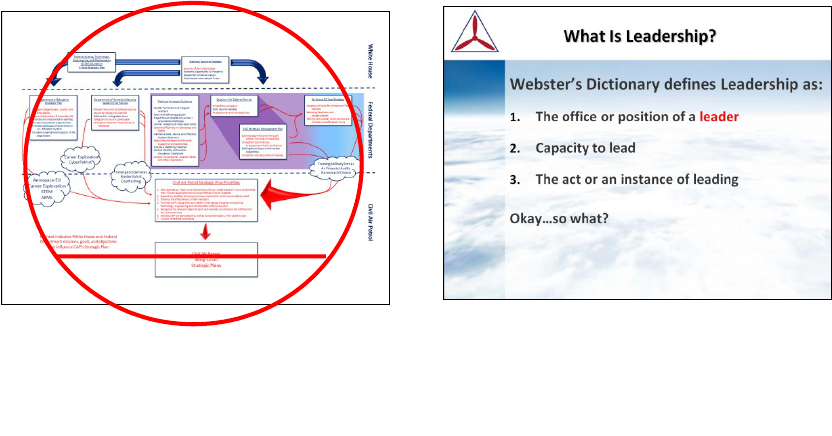
CAPP 1-2 01 October 2021
13
c. The same goes for the size of the font. Each slide should be readable from any seat in
the house. Not only do you need to know your audience, but you also need to know
your venue and presentation equipment.
d. Animation, when used effectively, can add an impressive flair to a presentation.
However, don’t overuse animation. People often use animation to transition from one
slide to another or to “build” the slide as you’re discussing it to prevent the audience
from reading ahead. The problem is these transitions and “builds” are usually too slow
and, when added up, can increase the duration of the presentation. Additionally,
repetitive animation gets boring. Bottom line – there’s a time and place for everything
so use animation wisely.
e. As mentioned previously, video and pictures are worth a thousand words. Adding video
to a presentation can promote subject matter comprehension. However, imbedding
video into a presentation can be finicky. Just because it worked on your home
computer doesn’t mean that the video will perform flawlessly when you present it at
your speaking engagement, usually on a borrowed computer. Make sure you dry-run
your presentation on the computer to be used for delivering it.
f. Make sure your content flows seamlessly from start to finish. Think of your
presentation as a story that has a beginning and middle that ultimately lead to a logical
conclusion. To think of it a different way, imagine someone telling a joke where they
start off with the punch line. It just doesn’t make sense and neither will your
presentation if it doesn’t flow.
g. Finally, the structure of the slides can add consistency and improve the meeting’s
productivity and predictability, especially for recurring events such as staff and progress
update meetings. Oftentimes the structure is determined by the person leading the
meeting, for example the unit commander or the director of an Emergency Operations
Center. A slide structure known as the “quad chart” is commonly used due to its
simplicity and to-the-point display of information. In practice, each quadrant has a title
Don’t be this guy, unless of course
you’re trying to make a point…or
you don’t want any friends!
Good example – clean, simple and
easy to read. It’s also presented on
the CAP brand-standardized slide.
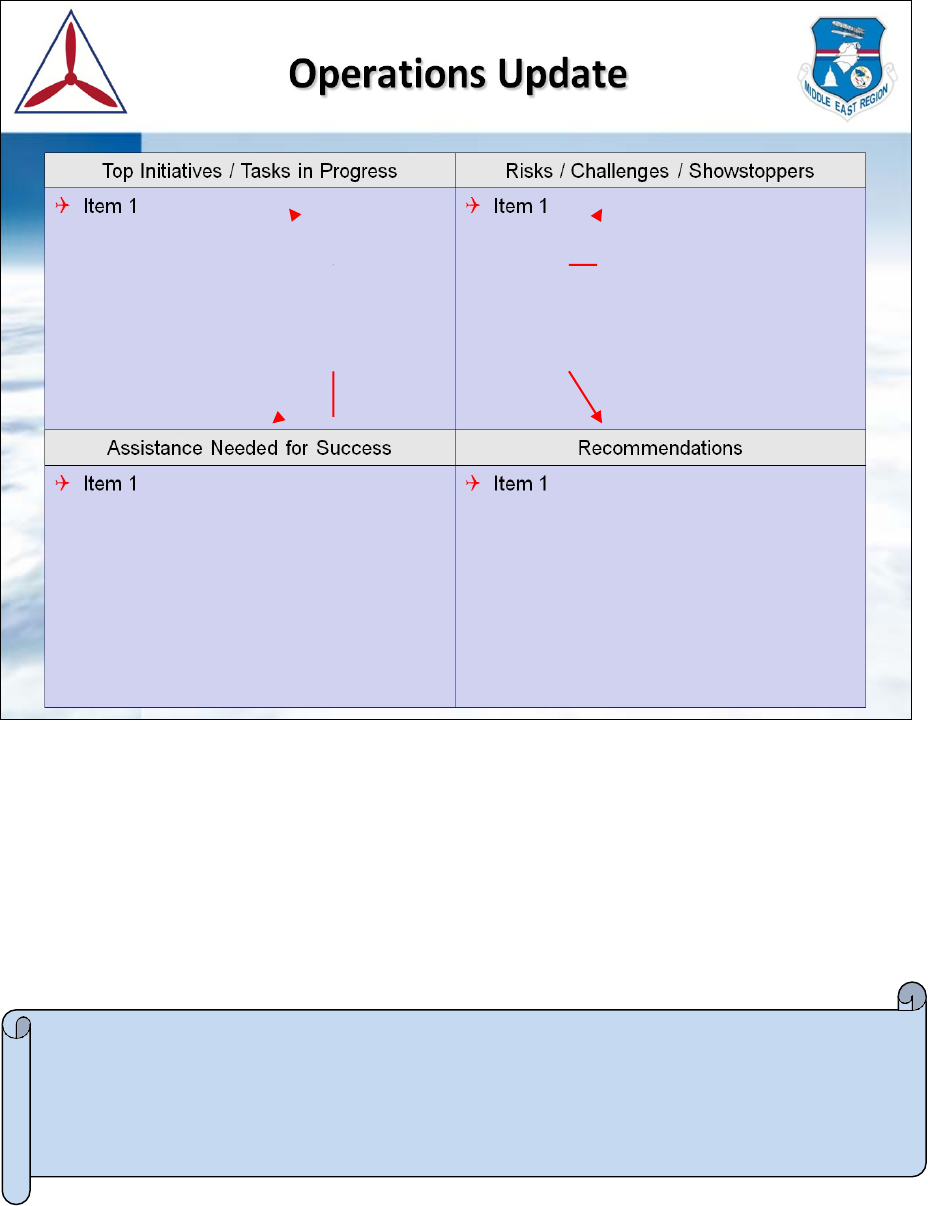
CAPP 1-2 01 October 2021
14
“When I was growing up, my mother would always say, ‘It will go on your permanent
record.’ There was no ‘permanent record.’ If there were a ‘permanent record,’ I’d
never be able to be a lawyer. I was such a bum in elementary school and high school.
There is a permanent record today, and it’s called the internet.”
Alan Dershowitz
and supporting bullets. The quadrant titles will vary with the meeting’s purpose or
desires of the lead person. An example of a quad chart is shown below.
I WANT TO SEE THAT IN WRITING
It is one thing to speak to an audience, but the real proof is found in written correspondence.
And proof it is. If you sign your name to it, or the correspondence came from your email or
social media account, it becomes difficult to say you didn’t write it. As mentioned previously, it
must be assumed that anything posted online, to include emails and social media sites, is visible
to the entire world. Oh, and if it’s on the internet, it’s there forever. That’s not said to scare,
rather it’s mentioned as a word of caution to ensure what you write is always professional and
reflects favorably on the Civil Air Patrol.
Quad chart titles vary with the needs
of the meeting or the discretion of the
person running the meeting

CAPP 1-2 01 October 2021
15
Most written CAP correspondence fall into one of three types. The purpose, audience and
desired “professional impact” determine which type to use. Templates for the memorandum
and business style letters can be found on the CAP publications website.
a. Memorandum Style Letter. This style is used for correspondence between CAP units
and when communicating with military agencies.
b. Business Style Letter. This style is used for correspondence with private concerns and
individuals not connected with CAP.
c. Electronic Mail (Email). Email is often an appropriate substitute for an official style
letter. Email also serves as the preferred avenue for coordinating publication revisions
or other actions requiring approval. This coordination is usually referred to as the
electronic Staff Summary Sheet, or eSSS for short.
Other types of CAP written correspondence include, but are not limited to:
a. Meeting Minutes. Minutes become the record of what occurred during a meeting. Of
most value are the issues discussed and the decisions made, to include the debate, to
resolve the issue.
b. Personalized Letters. These letters serve many purposes. Most often, personalized
letters are written to show gratitude for an individual’s contributions or to foster
partnerships.
c. Point Papers. The papers serve as memory ticklers or quick-
reference outlines to use during meetings or to informally pass
information quickly to another person or office. The format is similar
to a talking paper.
d. Talking Papers. A talking paper is a quick-reference outline on key
points, facts, positions, and views of others to use during oral
presentations.
e. Background Papers. A background paper serves as its name
implies, it provides the reader with a summarized chronological
background of an issue, the current matter to be addressed and
possible courses of action.
f. Position Papers. These papers evaluate a proposal, raise a new
idea for consideration, advocate a current situation or proposal, or
“take a stand” on an issue. Position papers are sometimes referred to
as advocacy papers.
For more
information
on these
papers,
refer to Air
Force
Handbook
33-337
The Tongue
and Quill
Or see the
templates
on the CAP
publications
web page.

CAPP 1-2 01 October 2021
16
Summary of Air Force Style Papers
Form
Function
Point Paper
• Single issue
• Single page
• Bullets or phrases
• Minimal data
Memory jogger: minimal text outline of a
single issue to quickly inform others
extemporaneously (no-notice)
• Conveys a single, narrow message in a very
short time, such as with an “elevator
speech”
• Give the same short message many times
• Requires prior research and content
memorization
Talking Paper (TP)
• Single issue
• Single page
• Bullets or phrases
• Key reference data
Speaking notes: outlines and narrates a single
issue to inform others during
planned/scheduled oral presentations
• Serves as a quick reference on key points,
facts, positions
• Addresses frequently asked questions
• Can stand alone for basic understanding of
the issue
Bullet Background Paper (BBP)
• Single issue or several related issues and
impact
• Single or multi-page
• Bullet statements
Background of a program, policy, problem or
procedure; may be a single issue or
combination of several related issues
• Concise chronology of program, policy,
problem, etc.
• Summarizes an attached staff package
• Explains or details an attached talking paper
Background Paper
• Single issue or several related issues and
impact
• Multi-page
• Full sentences, details
• Numbered paragraphs
Multipurpose staff communications
instrument to express ideas or describe
conditions that require a particular staff
action
• Detailed chronology of program, policy,
problem, etc.
• Condenses and summarizes complex issues
• Provides background research for oral
presentations or staff discussions; informs
decision makers with details
Position Paper
• Single issue or several related issues and
impact
• Multi-page
• Full sentences, details
• Numbered paragraphs
Working with proposals for new program,
policy, or procedure, or plan for working a
problem
• Circulate a proposal to generate interest
(initiate the idea)
• Evaluate a proposal (respond to another’s
idea)
• Advocate a position on a proposal to
decision makers
CAPP 1-2 01 October 2021
17
g. Forms. Yes, believe it or not, forms are another type of written correspondence.
h. Greeting and Note Cards. Short and to the point, these cards make a memorable impact
with visitors and new members.
i. Hand-written Notes. In the electronic age, hand-written notes are seldom used.
However, authors should never underestimate the impact these notes make with the
receiver. The fact that the author takes the time to prepare a hand-written note
conveys sincerity in the message.
Military style documents possess a language of their own, often using acronyms to shorten
common phrases or when referring to office symbols. This is not unique to military agencies as
many federal, state and local government agencies have their own style. It is preferred for
authors to write in the style of their intended recipient.
CAP is no different. Given our close association to the Air Force, we too use our own acronyms
and office symbols. Office symbols are shortcuts representing the organization structure and
functional responsibility. Office symbols may be used on correspondence, e-mail, forms, etc.
Major functions have two-letter symbols, for example, director of operations (DO). Since basic
functions report to major functions, basic functions have three-letter (or more) symbols. For
example, the emergency services officer is expressed as DOS. A basic function’s office symbol
starts with the same letters as the parent function’s office symbol, and adds one more letter. In
this case, the emergency services training officer is represented by DOST and the assistant ES
officer would be DOSA.
There is one exception to the two-letter office symbol. CAP’s Chief Operating Officer is
identified as CAP/COO, a position reflecting CAP’s corporate status and common across many
industries.
Office symbols may be used alone (CC) or with the organization designation (CAP/CC). Some
office symbols apply to specific command levels or organizations. For example, GLR/XX for
Great Lakes Region, MIWG/XX for Michigan Wing, MI248/XX for Kellogg Senior Squadron, or
CAP-USAF/XX for Headquarters CAP-USAF. Shown on the next page are commonly used CAP
office symbols.
CAPP 1-2 01 October 2021
18
Commander .......................................... CC
Vice Commander ................................... CV
Deputy Commander .............................. CD
Deputy Commander for Cadets ......CDC
Deputy Commander for Seniors ..... CDS
Chief Operating Officer (NHQ only) ... COO
Chief of Staff ...........................................CS
Deputy Chief of Staff ....................... DCS
Command Chief Master Sgt ................. CCC
Executive Officer ...................................XO
First Sergeant ...................................... CCF
(Cadet or Composite Squadrons only)
Administration ......................................DA
Aerospace Education ............................ AE
Cadet Programs ..................................... CP
Chaplain ................................................. HC
Communications (Director) ................... DC
e-Learning (NHQ only) ............................ EL
Finance ................................................. FM
Wing Financial Analysts.................. FMA
General Counsel (NHQ only) ................. GC
Government Relations Advisor ..............GR
Government Relations (NHQ only) .....GVR
Health Services ...................................... HS
Historian ............................................... HO
Human Resources (NHQ only) ...............HR
Information Technology...........................IT
Inspector General ................................... IG
Legal Officer ........................................... JA
Logistics ................................................. LG
A/C Maintenance Officer ............... LGM
Supply Officer ................................. LGS
Transportation Officer .................... LGT
National Operations Center................ NOC
Operations ............................................ DO
Communications (NHQ only).......... DOK
Counterdrug ................................... DOC
Emergency Services ........................DOS
Homeland Security ......................... DOH
Operations Training........................ DOT
Standardization & Evaluation ........ DOV
Personnel .............................................. DP
Plans and Programs ............................... XP
Professional Development .................... PD
Public Affairs ......................................... PA
Safety .....................................................SE
Wing Administrator (NHQ employee) ..WA
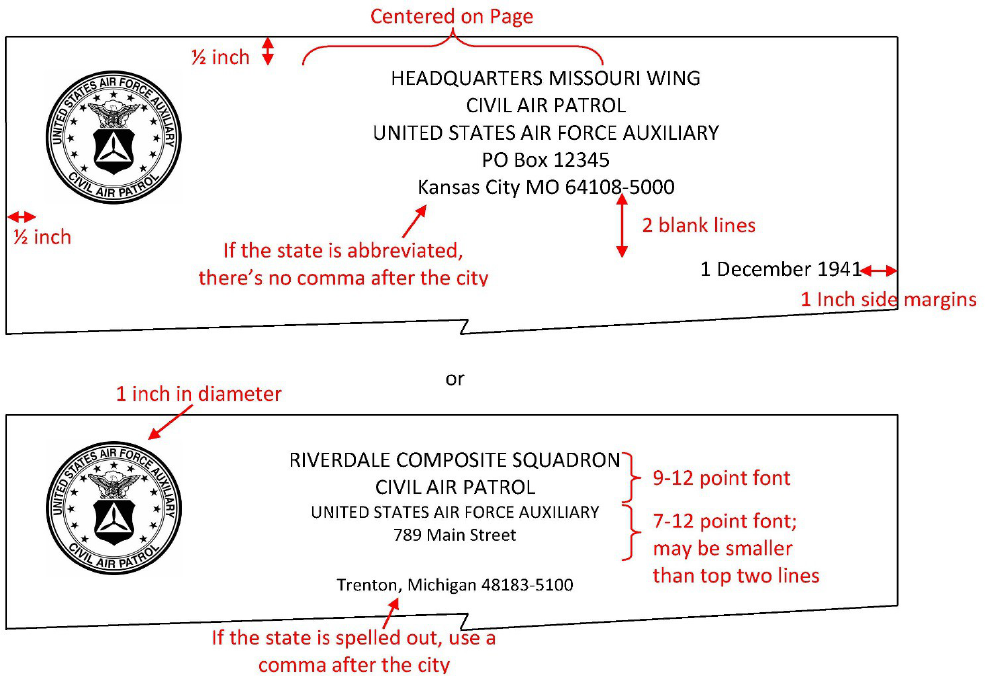
CAPP 1-2 01 October 2021
19
Getting A Head Start – Using Letterhead
Preprinted letterhead is preferred when writing a memorandum or business style letter. The
use of preprinted letterhead is optional for other types of written correspondence. Preprinted
letterhead standardizes the look of professional correspondence and draws the reader’s
attention to the CAP brand.
CAP’s standard letterhead includes these elements: unit designation; the words "Civil Air
Patrol"; "United States Air Force Auxiliary"; and the geographic location of the unit. The words
"United States Air Force Auxiliary" and the geographical information may be a smaller font than
the unit designation and “Civil Air Patrol”. For example:
Letterhead starts 1/2 inch from the top edge and is centered on the page. Letterhead should
be in a sans serif style font, meaning that the letters do not have a “tail,” “feet” or other
decorative flourishes. For example:
Apple (Times New Roman serif font) Apple (Calibri sans serif font)

CAPP 1-2 01 October 2021
20
Calibri is the preferred font, especially if you anticipate the document being viewed online.
Studies have shown that serif style fonts are easier to read in printed format while sans serif
fonts are more easily read online.
The CAP seal is used on the memorandum style letter. For all other correspondence, the CAP
seal, CAP emblem, unit patch/emblem, or other distinctive decoration may be printed on the
letterhead as long as it is in good taste (Refer to CAPR 900-2, Use of Civil Air Patrol Seal and
Emblem; Use and Display of the United States Flag and Civil Air Patrol Flags, for instructions on
use and illustrations of the CAP seal and emblem).
The CAP seal is 1 inch in diameter. Unit distinctive patches/emblems are 1 inch wide. Align the
seal/patch/emblem 1/2 inch from the left and top edges of the paper. If a higher headquarters
seal is placed in the upper left corner, subordinate units may add their unit seal/patch in the
upper right corner. The unit seal/patch is also 1 inch wide; however, it’s positioned 1/2 inch
from the right and top edges of the paper.
CAP seal graphics are available on the CAP Brand Portal at brand.gocivilairpatrol.com.
Email Memorandum. Letterhead may be superimposed into an email that is intended to be an
official correspondence. The heading element normally applies to a hard copy memorandum or
to a memorandum prepared as an attachment to an e-mail, but may be used in a memorandum
style email as well.
The Memorandum Style Letter
The memorandum style letter serves as an official communication internal to CAP as well as
military agencies. It may also be used when writing to other government agencies; however,
some agencies might be more receptive to the business style letter so it helps to know your
audience. The letter is typically written on standard 8 ½ by 11 inch white paper; however, an
alternate email version is acceptable to a CAP recipient.
The memorandum style letter has several elements, each discussed in detail below. These
elements are: heading element, body, closing element, attachment element, courtesy copy
element, and endorsements.
Heading Element. The heading element of the memorandum style letter includes the date, the
recipient(s), the sender, and the subject. This format is standardized for both paper and
electronic memorandum letters.
Date. Type or stamp the date on the right margin of the memorandum and on the third line
below the last line of the letterhead (Note: if no letterhead is used, place the date 1 inch from
the top edge of the page). Indicate the date in the format of day, month, and year; for
example, 6 Jun 12 or 6 June 2012. As a general rule, when the month is shortened, such as Aug,
then the year is shortened to the last two digits. When the month is spelled out, such as
August, the date is completed with the four-digit year. Unless the date of signature has legal
significance, date the original and all copies of the correspondence at the time of dispatch.
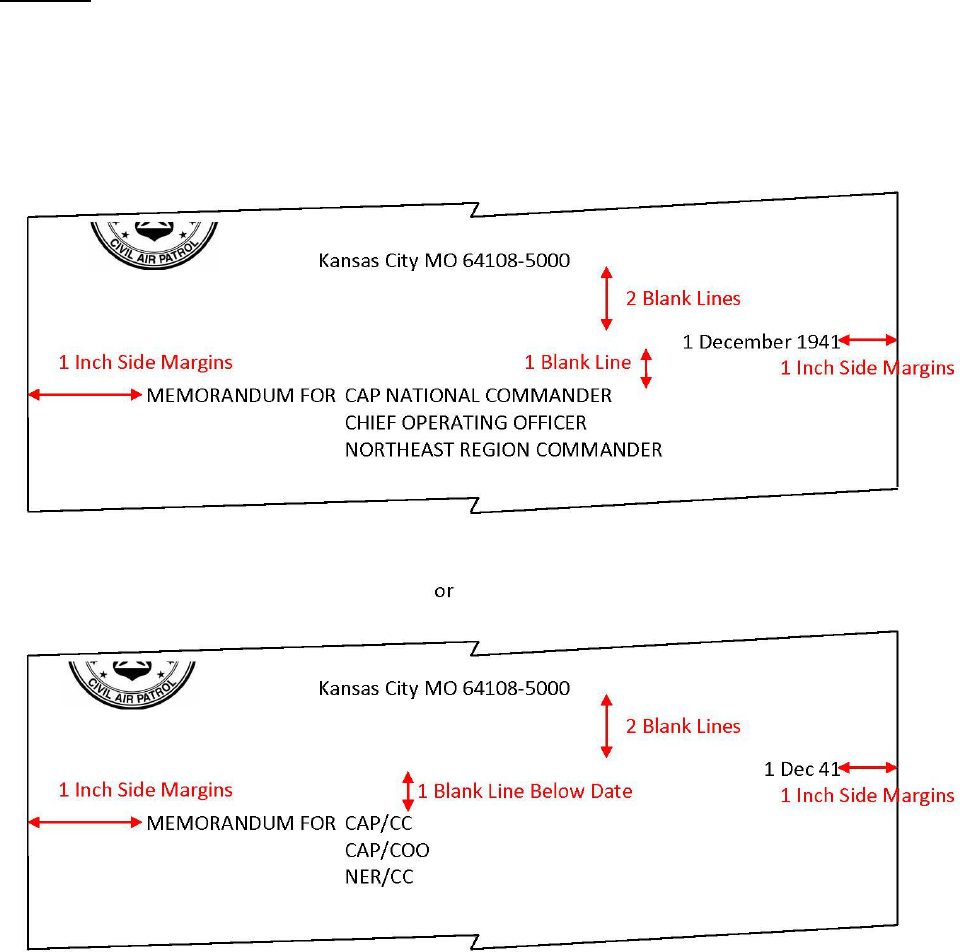
CAPP 1-2 01 October 2021
21
However, you should date correspondence prepared for reproduction with the date it will enter
the distribution system.
Recipient. The recipient of the letter is indicated on the MEMORANDUM FOR. The
MEMORANDUM FOR line begins on the second line below the date. Multiple recipients of the
same memorandum are listed below and in line with the first recipient, in order of precedence.
The MEMORANDUM FOR line is typed in all capital letters, spelling out the entire name or
position of the recipient. As an alternative, it is acceptable to abbreviate organizational office
symbols. Be consistent and use the same format throughout. For example:
When your list of addressees is too long to list in the heading, you may enter "MEMORANDUM
FOR DISTRIBUTION" and place the distribution list on a separate page attached to the
memorandum. An alternative is to list the recipients on the last page of the letter, two lines
below the attachment or "cc:" (courtesy copy) elements, if used, or in their place if not used.
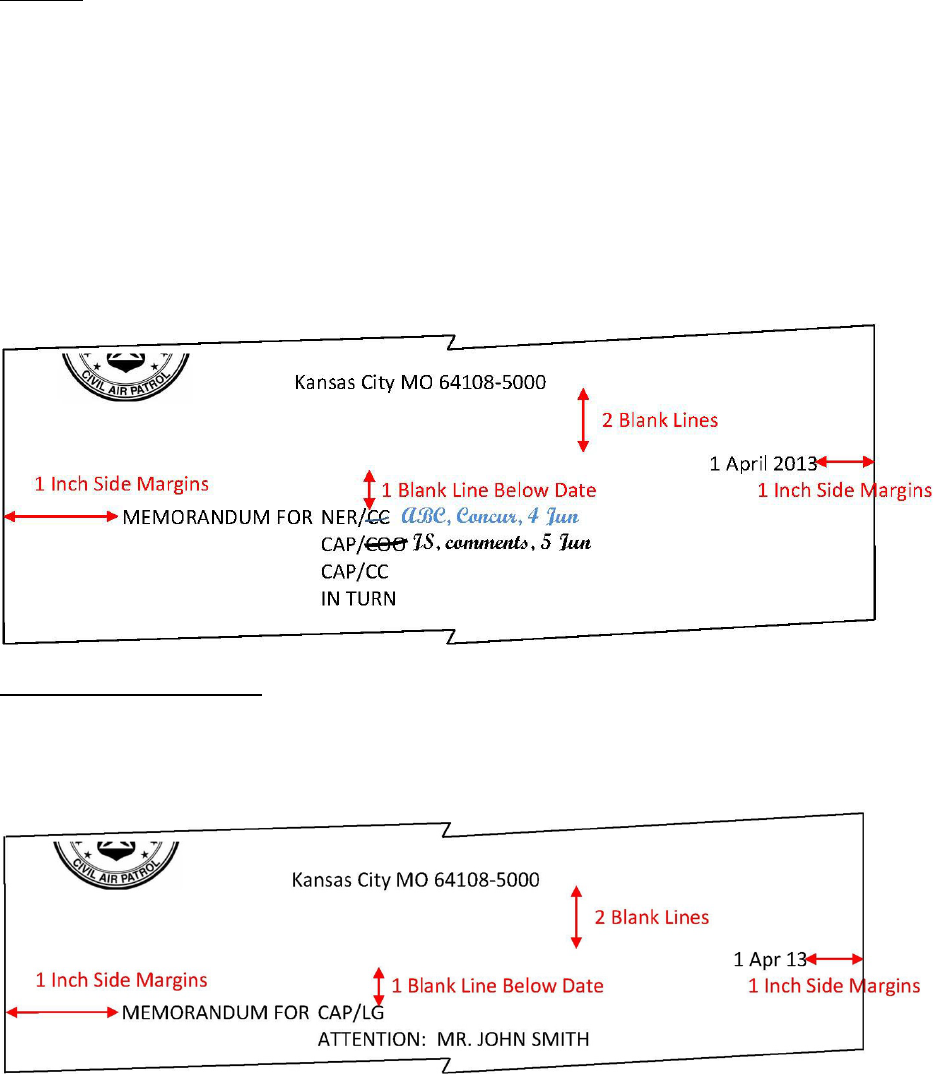
CAPP 1-2 01 October 2021
22
IN TURN. An "IN TURN" memorandum is used when you want to send the correspondence to
several recipients in sequence. It’s primarily used when the sender wants the final recipient to
see the coordination or action of the other recipients as the memo moves along the chain.
Unlike the above example where multiple recipients are listed in order of precedence, the IN
TURN memorandum is listed in reverse order of precedence. Align "IN TURN" under the first
word of the last addressee. In practice, recipients of a paper memorandum would line through
their office, initial, annotate concurrence/comments and date after their address signifying
receipt and acknowledgement. If comments are made, attach them to the memorandum prior
to forwarding to the next addressee. For email memorandums, receipt and acknowledgement
is usually reflected in the forwarded email thread, along with any comments. Here’s an
example of a paper IN TURN memorandum:
ATTENTION and THROUGH. If you address your memorandum to an office, but want a
particular person to receive it, use an "ATTENTION:" or "THROUGH:" line placed immediately
below and in line with the addressee’s office. This line may be shortened to read "ATTN:" or
"THRU:" in all caps. Here’s what an ATTENTION addressee should look like:
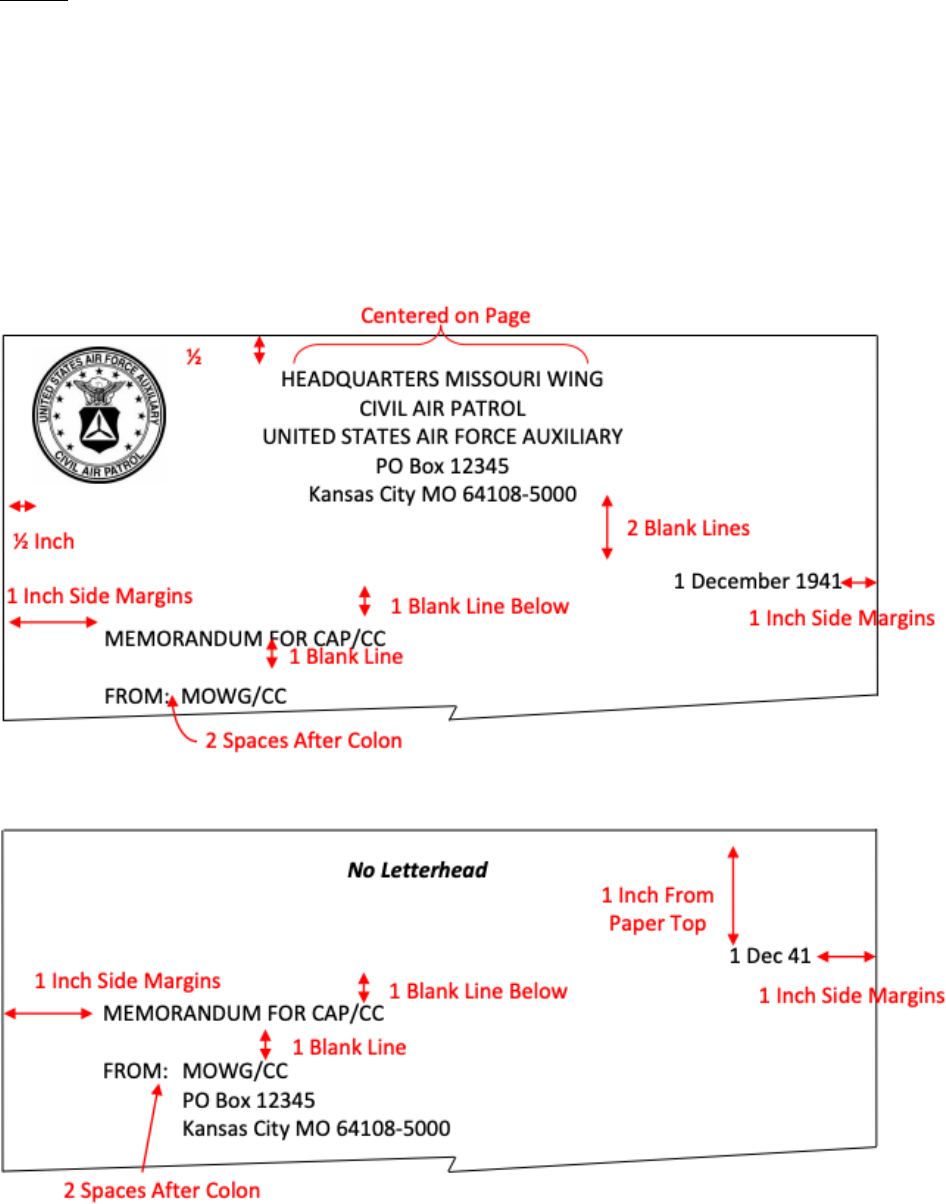
CAPP 1-2 01 October 2021
23
Sender. The sender is indicated on the “FROM: ” line; however, unlike the MEMORANDUM
FOR line, only the word FROM, or office symbols if used, are spelled in all capital letters. The
FROM line is entered on the second line below the last line of the MEMORANDUM FOR section.
If the letterhead contains the organization’s full mailing address, only the sender’s office
symbol is needed. If the full mailing address of the sender originating the correspondence is
not in the letterhead or there is no letterhead, the first line includes the organization
abbreviation and office symbol. Enter the delivery address (street or PO Box number), room or
suite number, and then the city, state, and zip code on the next two lines. If you wish to
include contact names, fax numbers, phone numbers or e-mail addresses, place them in the last
paragraph of the letter’s body. Here are two examples to show you how this should appear:
or
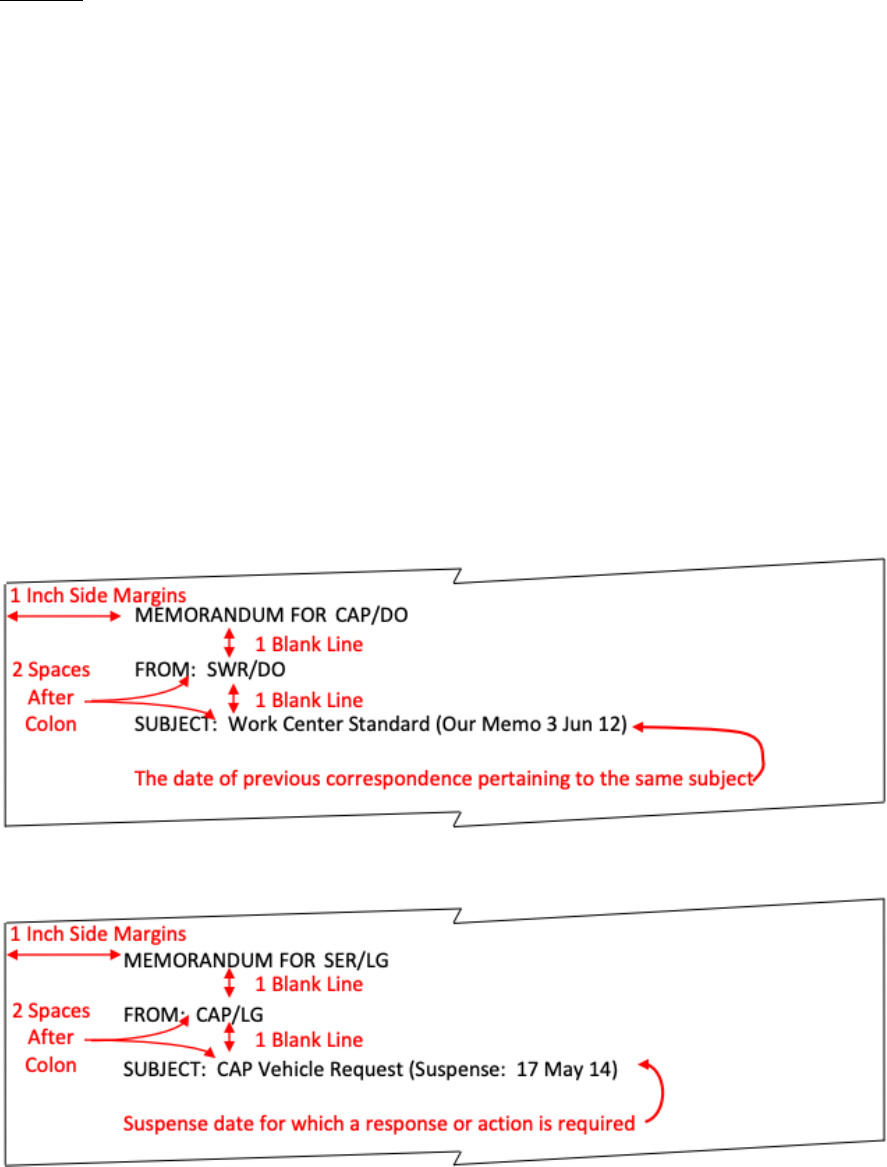
CAPP 1-2 01 October 2021
24
SUBJECT. The SUBJECT is nothing more than the title of the memorandum that summarizes the
letter’s content. Type "SUBJECT:" in all capital letters on the second line below the last line of
the "FROM" section. SUBJECT is the only word spelled in all capital letters; the remainder is
spelled using Title Case except for words, such as acronyms, that are always fully capitalized. As
a general rule, capitalize all words with four or more letters. Words with fewer than four letters
are capitalized except for:
a. Articles: the, a, an
b. Short conjunctions: and, as, but, if, or, nor
c. Short prepositions: at, by, for, in, of, off, on, out, to, up
If you need a second line, begin it directly under the first word of the subject’s first line. If you
refer to an earlier communication to or from the addressee on the same subject, or to another
correspondence or a directive, cite it in parentheses immediately after the subject. Send a copy
of the referenced correspondence if you feel the reader may not have it. Here are a few
examples:
or
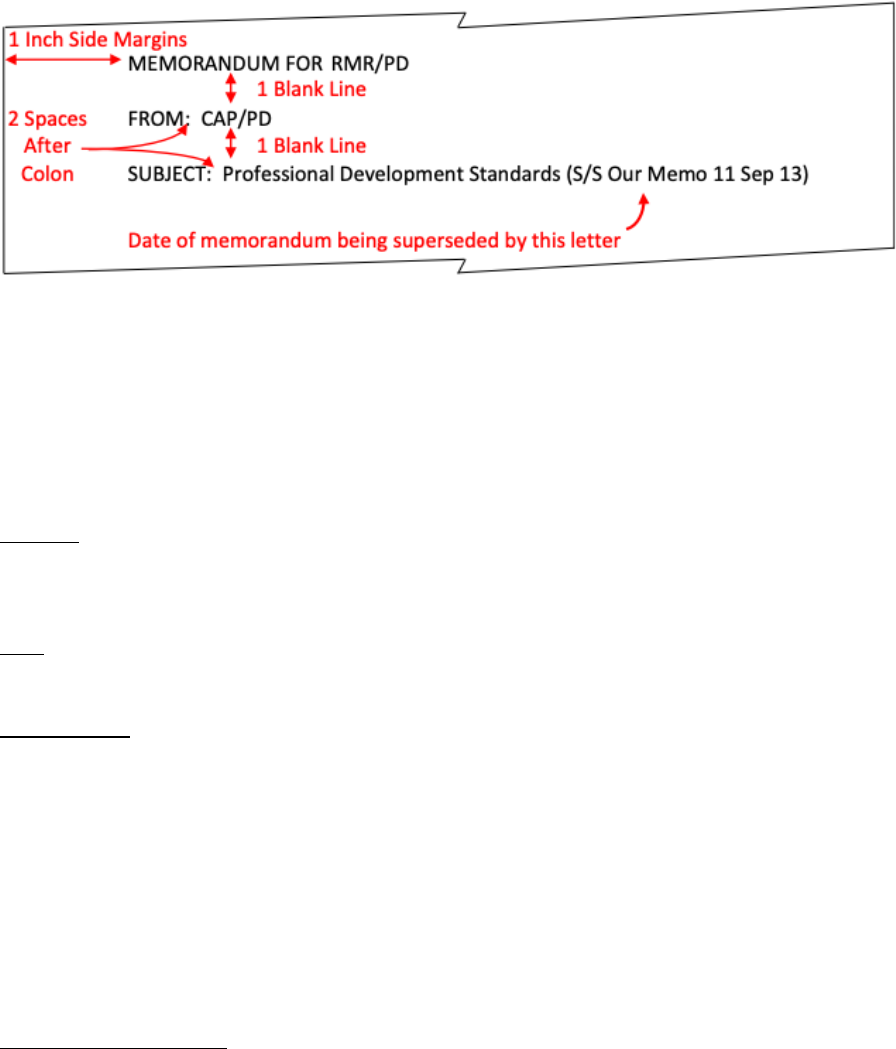
CAPP 1-2 01 October 2021
25
If the correspondence supersedes a previous correspondence, you may place a statement in
the subject line. Use "S/S" to indicate supersession, as indicated below:
Body. The body makes up the substance of the memorandum. Just like a speaking
engagement, the letter’s body should get to the point and provide sufficient information to
make sure the reader understands your message. Active voice is preferred; however, some
readers may find the message too direct. Passive voice softens the message, but often requires
more words and could change the tone or clarity of the message. Bottom line – know your
audience.
Margins. As indicated earlier, standard margins on hard copy letters should be 1 inch from all
edges of the paper. The one exception is letterhead, which is placed ½ inch from the top and
sides. The remainder of the letter is framed with 1-inch margins.
Font. Given that most documents are passed electronically and viewed online, the preferred
font for memorandum letters is Calibri, a sans serif style font.
Paragraphing. The memorandum body, either in paper or email format, starts on the second
line below the last line of the subject. Main paragraphs are numbered and not indented, with a
blank line between paragraphs. Subparagraphs are lettered. A single paragraph is not
numbered. In other words, there is no “1.” if you don’t have a second paragraph. This same
rule applies to subparagraphs; if there is only one subparagraph, then it’s better to make it a
main paragraph.
Closing Element. The closing element is nothing more than the signature block, which starts at
page center and on the fifth line after the last paragraph in the body. There is one exception to
this rule – FOR THE COMMANDER.
FOR THE COMMANDER. This phrase is used only on the memorandum style letter and only
when the author is directed to write correspondence, or if the author is issuing correspondence
that would normally be issued by the commander. FOR THE COMMANDER begins at page
center and on the third line below the last line of text. The commander’s signature block
follows on the fifth line. For example:
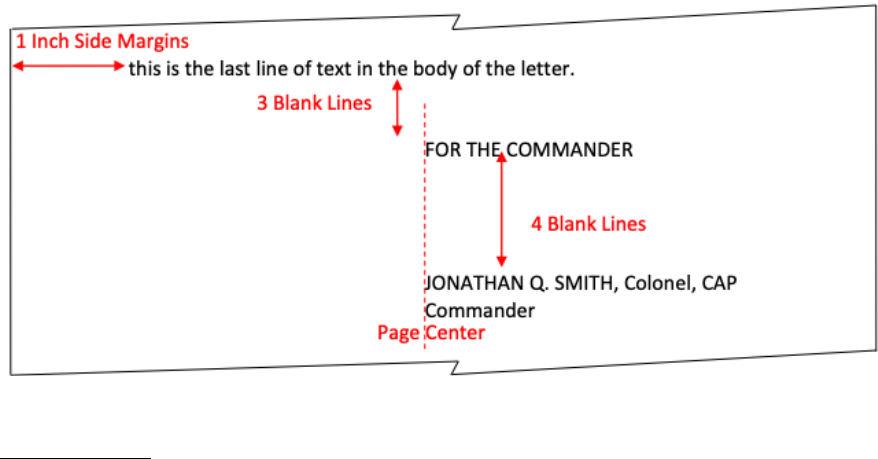
CAPP 1-2 01 October 2021
26
Signature Block. The signature block identifies who is releasing the letter, which may be
different than the author. The signer is the person with authority to release the letter and,
once signed, is an indicator they agree with the letter’s content, regardless of who wrote it.
The writer’s signature is placed in the space immediately above the signature block.
The signature block comes in two standard formats: a two-line and a three-line block.
a. The two-line format is the preferred signature block and consists of the signer’s name in
all capital letters, the signer’s grade in Title Case, and finished with “CAP” on the first
line. The second line states the signer’s duty title in Title Case.
b. The three-line signature block may be used when the name and grade or the duty title
are too long for a two-line format.
In either of the above cases, the grade is normally abbreviated using the standard convention,
such as “Lt Col” or “C/MSgt”. It is permissible to spell out the entire grade if doing so doesn’t
needlessly force a three-line signature block, for example “Major” or “Colonel”. Additionally, if
the “FROM:” block clearly identifies the signer’s unit, for example RMR/CC, it is acceptable to
simply state “Commander” as the duty title in the signature block as opposed to spelling out
“Commander, Rocky Mountain Region”.
There is one exception to the “NAME, Grade, CAP” format. If it is customary to refer to
someone by their specialty instead of their grade, then the specialty is reflected after the
signer’s name. This exception is almost always made for chaplains, but on rare occasions, it
might be seen in signature blocks of medical professionals.
The use of graphics, quotes or phrases are inappropriate for signature blocks.
Here are a few examples of the various signature blocks:

CAPP 1-2 01 October 2021
27
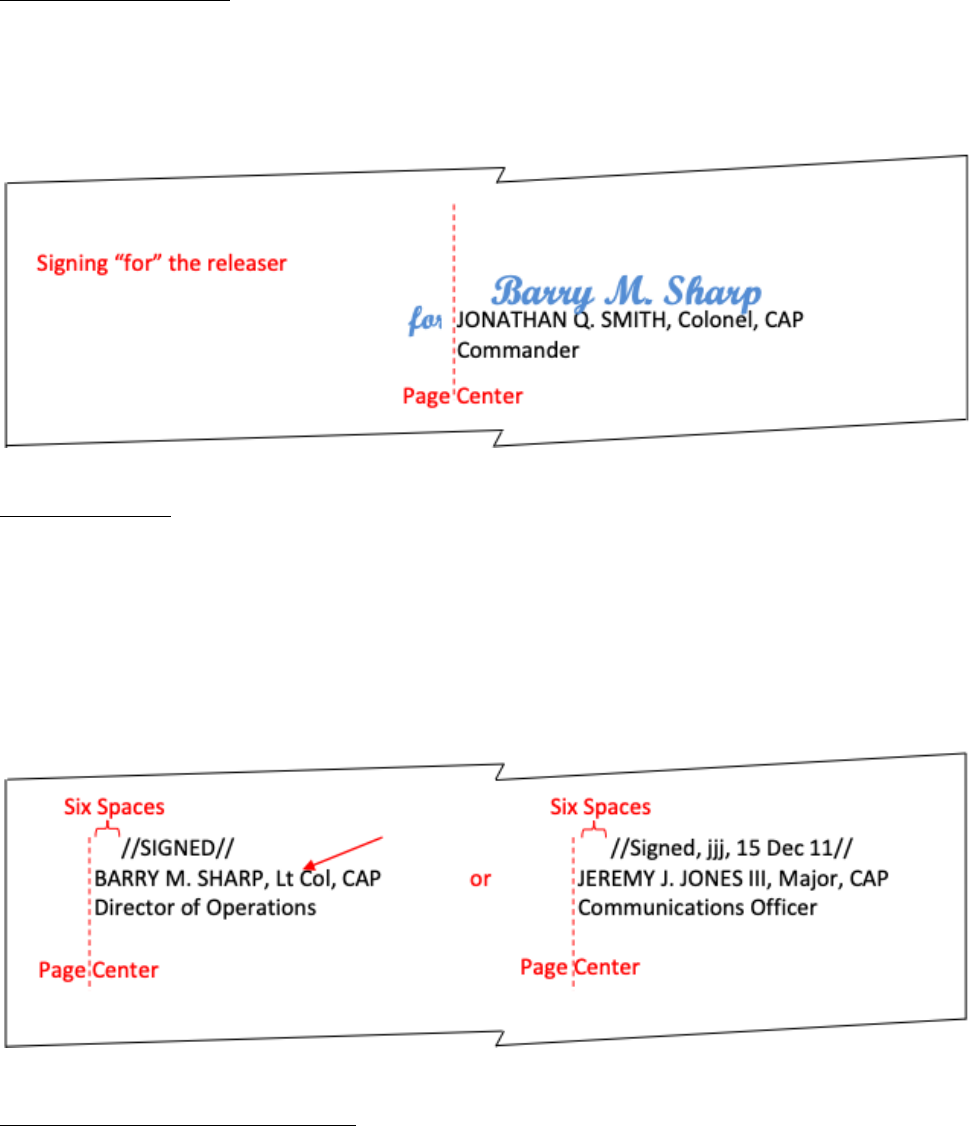
CAPP 1-2 01 October 2021
28
Signing for the Releaser. Occasionally the person who would normally sign the correspondence
is not available to apply his/her signature. In this case, the individual who has temporarily
assumed responsibility for the unavailable individual may sign in that person’s place. In
addition to signing his/her own name, the signer inserts the word “for” just prior to the
intended signer’s printed name. See example below:
Using //SIGNED//. When the correspondence has been approved for release by the signer and
applying a hand-written signature is not feasible, //SIGNED// may be used to indicate that the
correspondence is approved. //SIGNED// may also be used on text copies of correspondence
when the original was signed, and may also be used for signing e-mails. Consider written
correspondence received via e-mail, copied or stamped “//SIGNED//” as authoritative. A
common alternative to //SIGNED// is to include the signer’s initials and date, for example
“//Signed, bms, 15 Dec 11//”. Place the //SIGNED// six spaces to the right of the center of the
page as shown below.
Email Memorandum Signature Block. For memorandum style email, follow the above signature
block guidance; however, instead of beginning the signature block at page center, the closing
element is positioned at the left edge of the document. The use of civilian or personal
signature elements is inappropriate for CAP email correspondence.
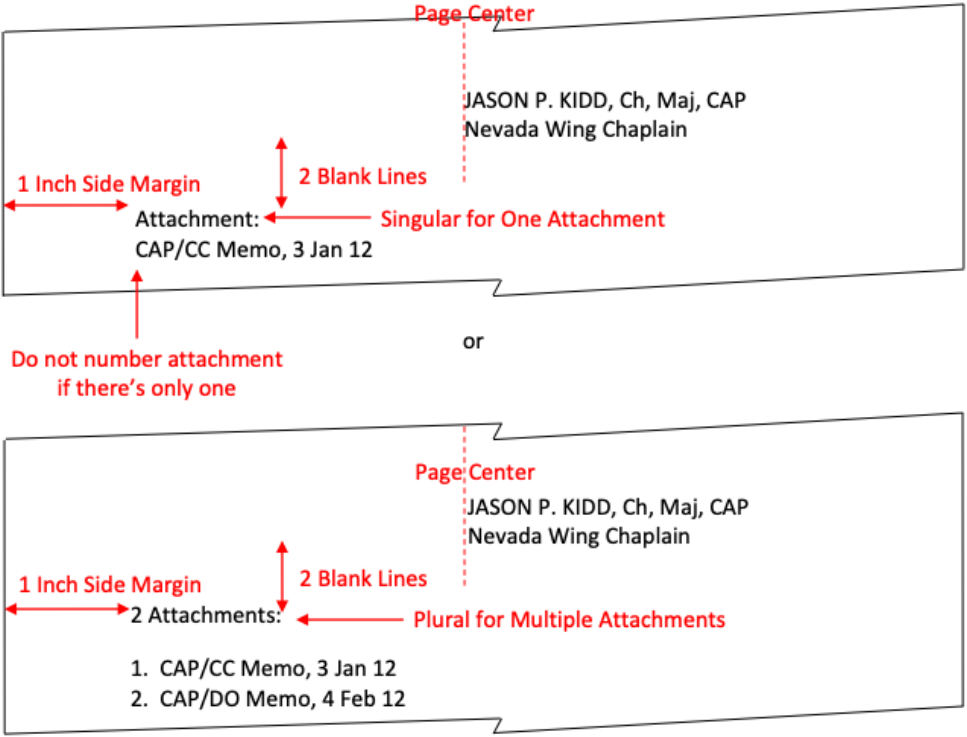
CAPP 1-2 01 October 2021
29
Attachment Element. When attachments accompany the memorandum, type
"Attachment(s):” at the left margin, on the third line below the signature element. If there is
more than one attachment, list each one by number in the order you refer to them in the
memorandum. Describe each attachment briefly. Cite the office or origin, the type of
correspondence and the date. The attachment element should not be split by a page break.
See examples below:
Courtesy Copy Element. If information copies are sent to individuals other than the
addressee(s), type "cc:" at the left margin, on the second line below the attachment element. If
there is no attachment element, type the courtesy listing starting on the third line below the
signature block. List names or organization designations and office symbols of those to receive
copies, one below the other. If a courtesy copy is sent without including the attachment(s),
indicate such by adding "w/o Atch" at the end of the line. For example:
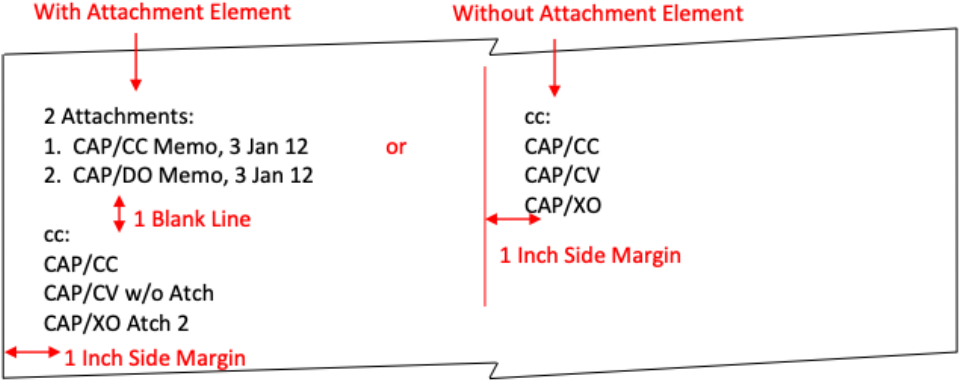
CAPP 1-2 01 October 2021
30
Endorsements. There are times when an originator lacks decision-making authority to initiate
actions outlined in the memorandum. Sometimes the action requires concurrence of others
before the approval authority makes a decision, or perhaps two approvals are required. One
option is to have all parties reply to the originator with their own concurrence/approval letters.
An easier alternative is to use an endorsement statement.
For a hard copy memorandum, endorsements follow the original correspondence, beginning on
the second line below the signature block, attachment element, or courtesy copy element,
whichever is last. The endorsement includes the numerical endorsement, a “TO:” line, a
“MEMORANDUM FOR” line to the next person in the endorsement chain (for multiple
endorsements), and an action line. It is completed with the signature block of the individual
taking the action.
Endorsement statements in a memorandum style email are much simpler. Email endorsements
may be positioned either above or below the original correspondence; however, they are
usually found at the top of the email due to forward/reply ease of emails. There is one
difference too; as mentioned previously, the email endorsement signature block is positioned
at the left edge.
An example of a two-endorsement statement is shown on the next page.
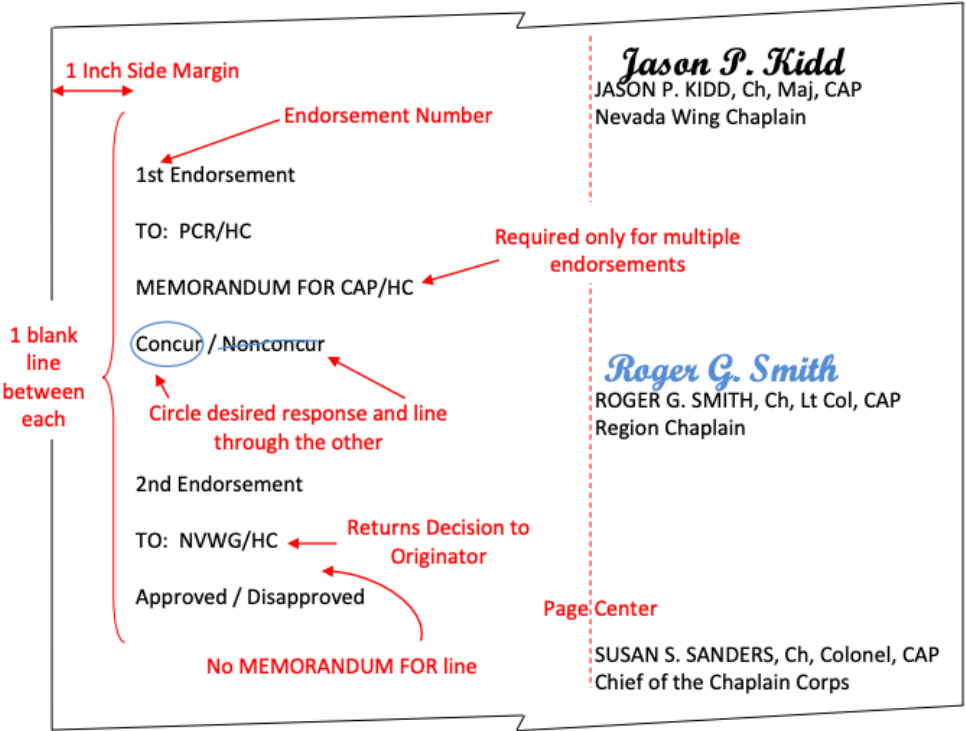
CAPP 1-2 01 October 2021
31
Putting it all together, the memorandum style letter might look like the example on the next
page.

CAPP 1-2 01 October 2021
32
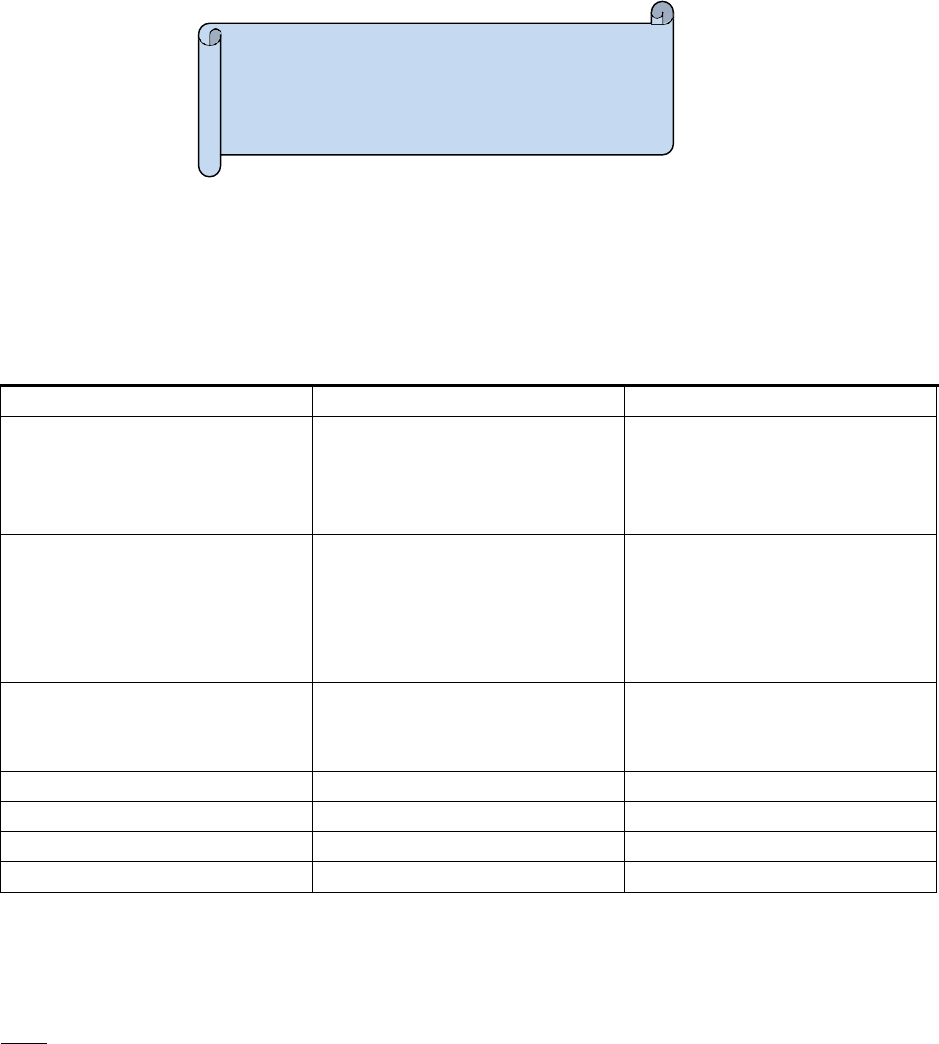
CAPP 1-2 01 October 2021
33
“Letters are something from you. It’s a
different kind of intention than writing an
email.”
Keanu Reeves
The Business Style Letter
The business style letter is used for correspondence of a private nature, such as a personal
thank you letter, or for recipients of a non-governmental nature, such as a partnership with
another non-profit organization. As such, there is much less structure than the formal
memorandum style letter.
The business style letter may be written on letterhead. Like the memorandum style letter, it
too has a header element, body and closing element; however, some of the other elements are
optional and some are not used. Each of these elements will be discussed in detail.
Aside from the structure, there are several key differences between the business style letter
and the memorandum style letter. These differences are highlighted below.
Element
Business Style Letter
Memorandum Style Letter
Letterhead
Optional
Optional
Heading Element
Date
Return Address
To Address
Salutation
Date
MEMORANDUM FOR
FROM:
SUBJECT:
Body
No paragraph numbers
Paragraphs are indented
Margins are 1 inch on all
sides (unless using
letterhead)
Paragraphs are numbered
Paragraphs are not indented
Margins are 1 inch on all
sides (unless using
letterhead)
Closing Element
Complimentary close,
normally using “Sincerely”
Normal signature block
Normal signature block
Courtesy Copy Element
Normally not used
Optional
Endorsements
Never used
Optional
Email Version
No
Yes
Overall length
Attempt to limit to 1 page
May be multiple pages
Heading Element. The business style letter heading element includes the date, sender’s
address, recipient’s address and the salutation.
Date. Type or stamp the date on the right margin of the letter and on the third line below the
last line of the letterhead. If letterhead is not used, place the date 1.75 inches (or 10 lines)
from the top edge of the page.

CAPP 1-2 01 October 2021
34
Indicate the date in the format of day, month, and year; for example, 7 Dec 12 or 7 December
2012. As a general rule, when the month is shortened, such as Aug, then the year is shortened
to the last two digits. When the month is spelled out, such as August, the date is completed
with the four-digit year. The date reflects the date the letter is actually signed.
Sender’s Address. If the stationery is not preprinted with the full address of the sender or
sender’s organization, then type the sender’s address using Title Case format. Begin typing the
address at the left margin on the fourth line below the date. Include name, grade and, if not on
letterhead, the complete mailing address of the sender.
Recipient’s Address. The recipient’s address follows the same format as the sender’s. Unlike
the sender’s address where the full address is optional if accurately displayed on letterhead,
the recipient’s address is always provided in full. The recipient’s address begins on the third
line below the sender’s address block.
Salutation. The salutation introduces the body of the letter and begins on the second line
below the recipient’s address block. It is preferred that the sender know the name of the
recipient. In this case, the appropriate salutation takes the form of “Dear Title Last Name”, as
in "Dear Inspector Jones" or "Dear Mr. Brown". If the recipient’s name is not known, an
acceptable salutation is “Dear Sir” or “Dear Ma’am” however doing so presents the sender with
a 50-50 chance of getting the gender correct. A better alternative is to address the letter by
professional or organizational title, such as “Dear Department Head”. In any case, no
punctuation is used at the end of the salutation. Use punctuation after abbreviations such as
"Mr.," "Mrs." and "Dr."; however, no punctuation is used with abbreviated CAP/military grades.
The Tongue and Quill offers an extensive list of addresses, salutations and closures in the
Personal Letter section. For example, using letterhead might appear as shown on the next
page.
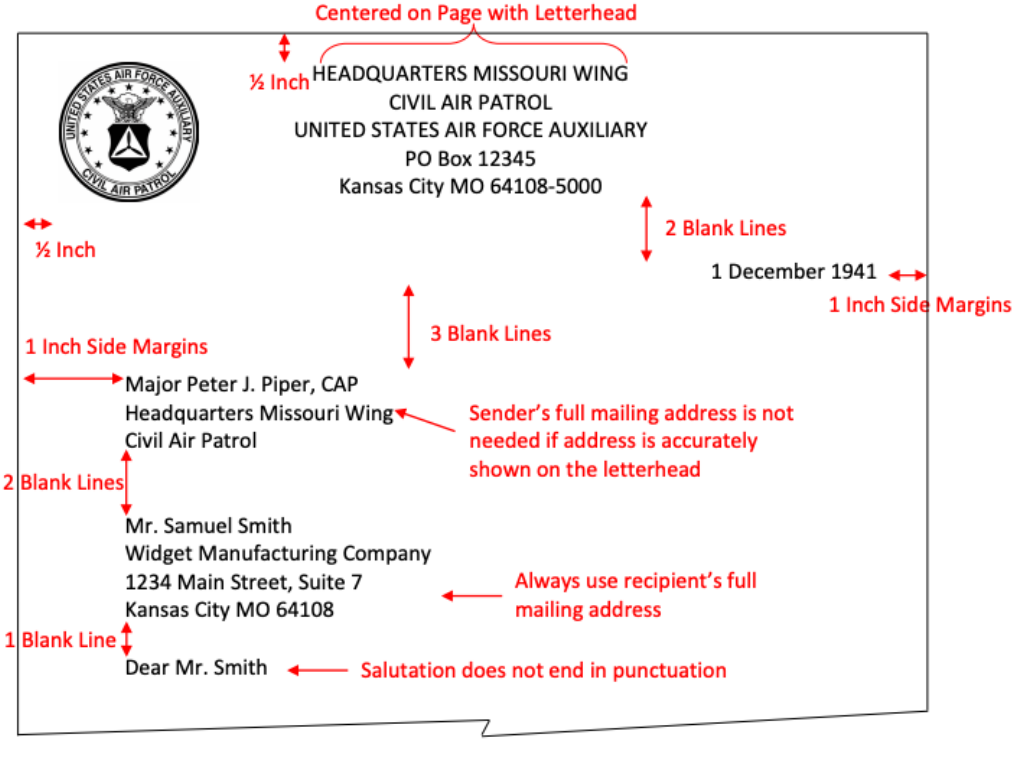
CAPP 1-2 01 October 2021
35
An example of the business style letter without letterhead is shown on the next page.
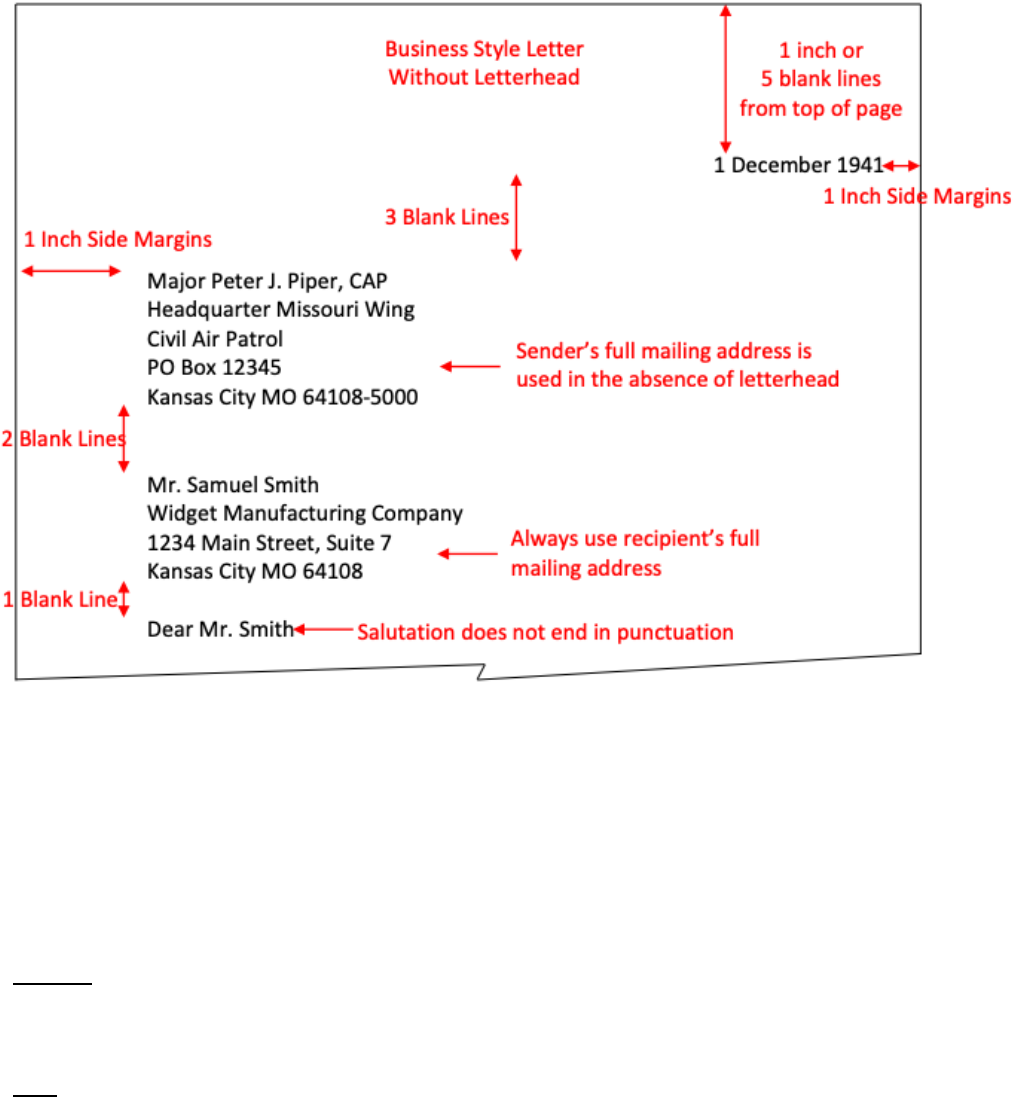
CAPP 1-2 01 October 2021
36
Body. The body makes up the substance of the letter and should get to the point while
providing sufficient information to make sure the reader understands your message. Business
style letters are best presented on one page; however, additional information may be included
as attachments.
Like the memorandum style letter, active voice is preferred; however, some readers may find
the message too direct. Passive voice softens the message, but often requires more words and
could change the tone or clarity of the message. Bottom line – know your audience.
Margins. Standard margins on hard copy letters should be 1 inch from all edges of the paper.
The one exception is letterhead, which is placed ½ inch from the top and sides. The remainder
of the letter is framed with 1-inch margins.
Font. Unlike the memorandum style letter, there is no acceptable email format for the business
style letter. However, an alternative to mailing the letter is to email the letter as an
attachment. Given that sans serif style fonts are more easily viewed on a computer, the
preferred font for business style letters is Calibri, a sans serif style font.
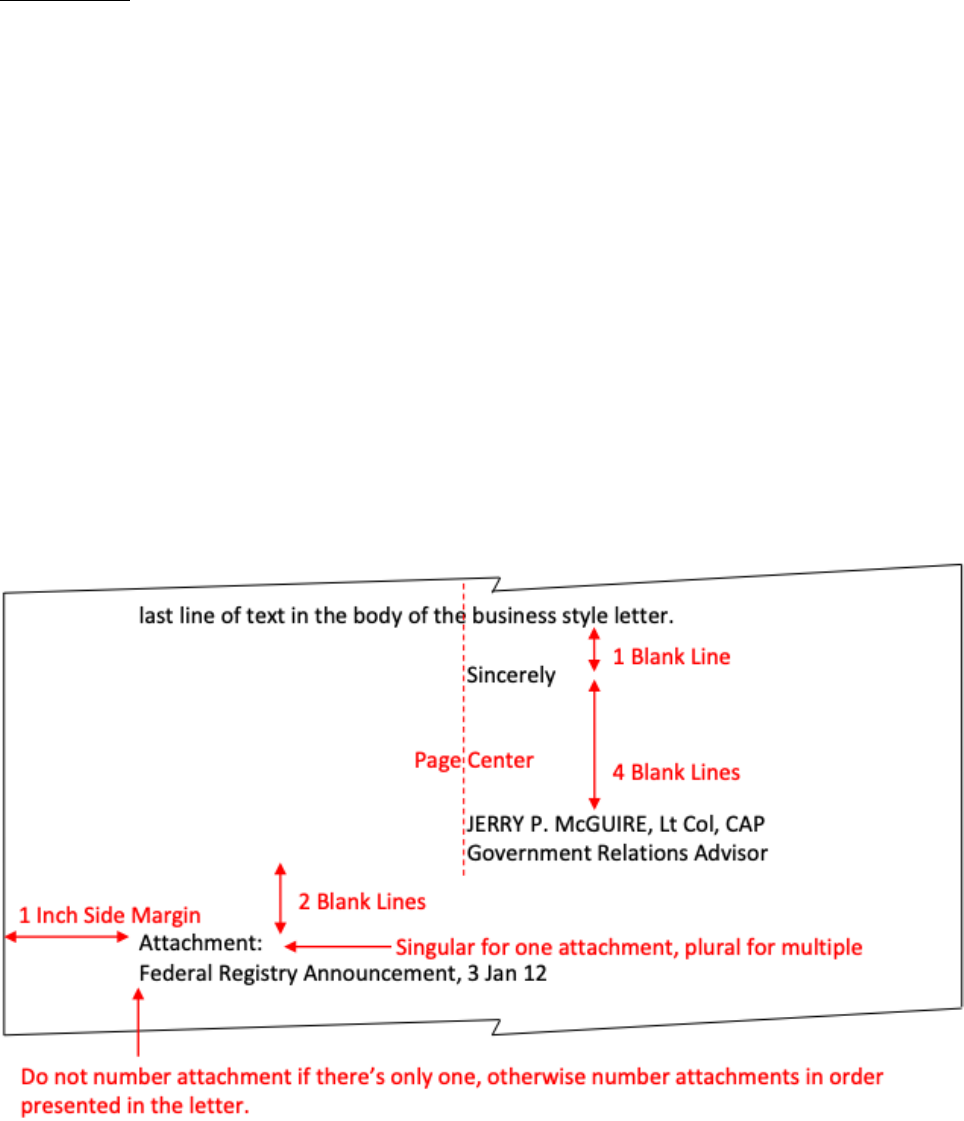
CAPP 1-2 01 October 2021
37
Paragraphing. Start the first paragraph on the second line below the salutation. Each
paragraph should be indented with a blank line between subsequent paragraphs. Do not
number paragraphs.
Single paragraph letters of less than eight lines may be double spaced to prevent an awkward
appearance with a lot of white space. An alternative to double-spacing short letters is to
format the letter in landscape mode, but only type on one half of the page. When printed, the
unused half may be removed. A better alternative is to print on appropriately sized stationary.
Closing Element. The business style letter closing element is sometimes referred to as the
complimentary close. The accepted convention is to type “Sincerely” starting at page center on
the second line below the last line of the body. There is no punctuation after “Sincerely” and
the standard signature block (see memorandum style letter) begins on the fifth line.
Attachment Element. When attachments accompany the business style letter, type
"Attachment:” at the left margin, on the third line below the signature block. If there is more
than one attachment, list each one by number in the order you refer to them in the letter.
Describe each attachment briefly. Cite the office or origin, the type of correspondence and the
date. The attachment element should not be split by a page break. An example of the closing
and attachment elements looks like this:
Putting it all together, the business style letter might look like the example on the next page.
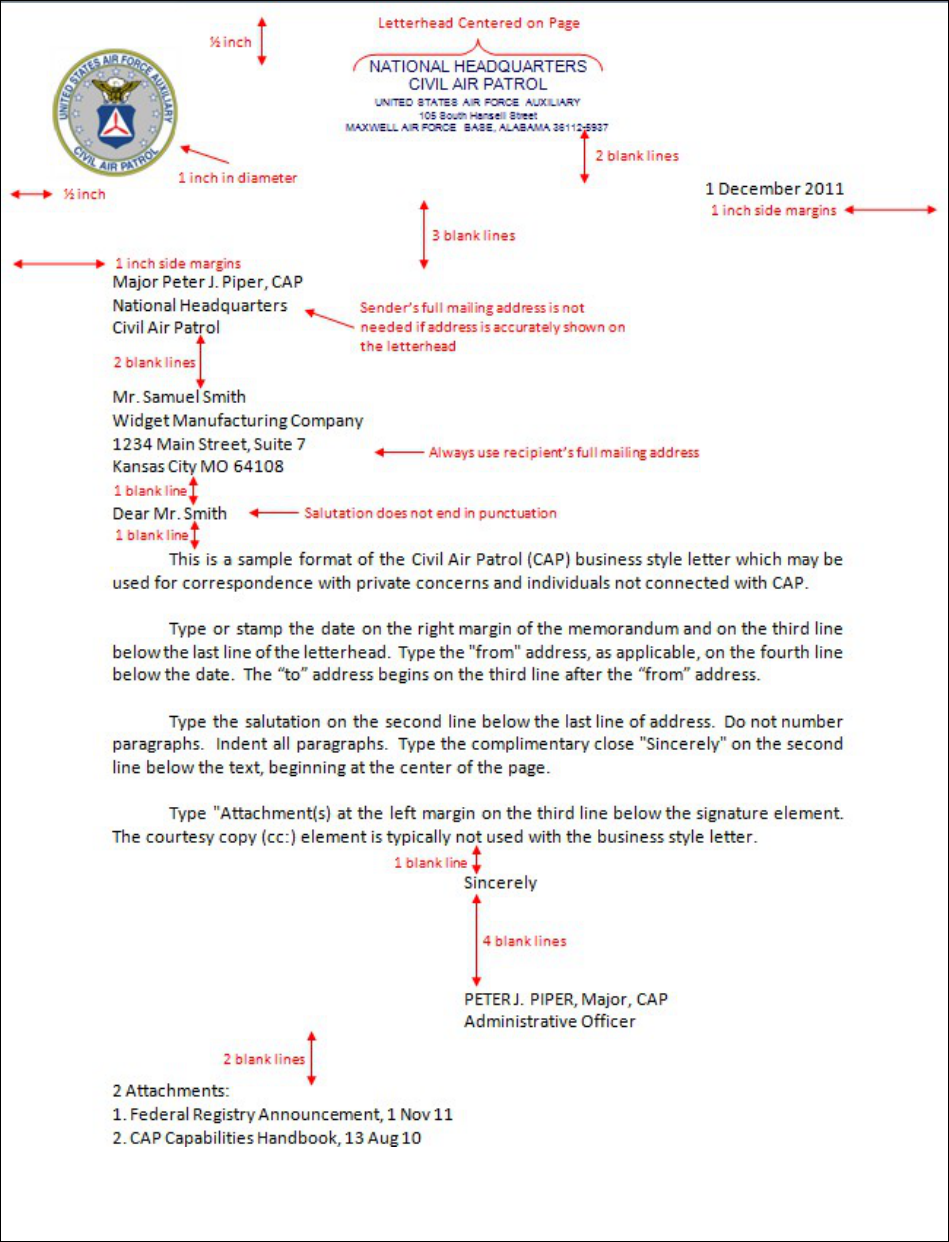
CAPP 1-2 01 October 2021
38

CAPP 1-2 01 October 2021
39
“People live too much of their lives
on email or the Internet or text
messages these days. We’re losing
all of our communication skills.”
Tracy Morgan
ELECTRONIC COMMUNICATIONS
Electronic communications are prevalent in the world today and occur in all forms, from a
simple email to social media, online video conferencing, smart phone applications, texts, web
pages, and many more. In fact, there are so many forms of electronic communication that this
topic could have its own publication. Couple that with near daily introduction of new means to
communicate and such a publication would be out of date before it’s even released. With this
in mind, the information below is more of a guide for do’s and don’ts in CAP, and not
necessarily a “how to” manual.
If you’re new to social media, most sites offer a help page to get you started. Additionally,
there are countless other resources available, many of which are free, to assist you in creating
professional emails, web pages and other forms of electronic communication. One such
resource is The Tongue and Quill chapter on Electronic Communication.
Communication is no longer challenged by distance; rather people on opposite sides of the
globe can communicate with the click of a mouse. The ease of electronic communication
presents both benefits and challenges. Probably the greatest benefit is the speed in which a
recipient, to include large audiences, can be reached. On the flip side, and probably worst of
all, never forget that if it’s on the internet, it’s there forever. So care must always be used
when communicating electronically.
Email. In CAP, email is by far the most
frequently used form of electronic
communication to conduct daily business. Not
only does email serve to communicate between
one or multiple recipients, but it also establishes
a record of what was communicated. For actions
requiring approval, this record is vitally
important.
A traditional email can replace or supplement other CAP written correspondence such as the
official memorandum. A memorandum style email may be used if guidelines for a
memorandum style letter are followed. Emails may also be used to send other written
correspondence by adding documents as attachments to the email.
“Social media is the most disruptive form of communication humankind has seen
since the last disruptive form of communications, email.”
Ryan Holmes
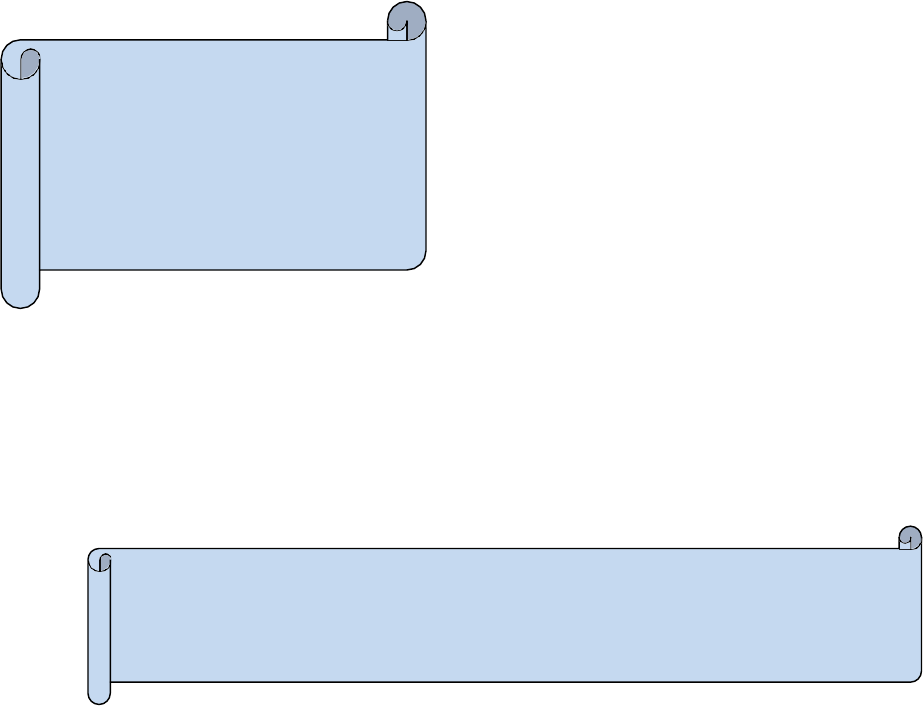
CAPP 1-2 01 October 2021
40
“I do love email. Wherever possible I try to communicate asynchronously. I’m
really good at email.”
Elon Musk
There are a number of factors to consider before using any form of e-mail. Some of the
advantages to using email are: 1) it’s fast; 2) it can get to more people; 3) it’s paperless.
Conversely, the same advantages can prove to be disadvantages: 1) it’s fast…a quickly written
email can fan as many fires as it extinguishes; 2) it can get to more people, some of which the
sender may not desire to be recipients, such as when a copy is forwarded into the wrong hands;
3) it’s paperless and while email does leave an electronic trail, hard drive failures and other
anomalies can make things disappear.
The following are general rules of thumb pertaining to emails and are also applicable to texting
and online postings to social media sites:
a. Repeat after me…never, ever send an email
when you’re mad! While it may be your initial
reflex to a situation, DON’T DO IT. If the situation
is an ugly dog, sleep on it. If it’s still an ugly dog
when you awake, then it’s probably an ugly dog.
Oh, and if it’s truly unprofessional, there are better
ways to handle the situation than a return email.
b. Don’t type using all capital letters. Doing so
comes across as SHOUTING…unless, of course,
that is your intention.
c. Email is essentially a one-way conversation and, unlike verbal communication, there
is no way to insert voice inflection or enunciation into an email. Invariably, the
emotion felt in crafting an email is seldom the same emotion sensed when reading
the email. The same goes for sense of humor. If it’s an important email, ask a
colleague to read it silently before you hit the send button. If your colleague senses
the same emotion or humor as you intended, then the real recipient is likely to
sense the same.
d. Know the difference between “To:”, “Cc:” and “Bcc”.
To: are the recipients you actually want the email to go to; those who need the
information you’re providing or are acting on something in the email.
Cc: are the “guest recipients” for which you’re providing awareness of the
information or action in your email. Don’t expect those in the Cc: line to act on
your email. Likewise don’t get offended if they provide their two cents worth.
“A wise man is superior to any
insults which can be put upon him,
and the best reply to unseemly
behavior is patience and
moderation.”
Moliere

CAPP 1-2 01 October 2021
41
Let’s face it; you invited them into the conversation. Caution – sometimes
replying to all changes recipients from the Cc: line to the To: line.
Bcc: is a blind courtesy copy. It’s blind because neither the To: or Cc: recipients
know others are receiving the email too. Just because your email program
allows Bcc’ing others it doesn’t mean that you should use the feature. Many
believe such blind copying is unethical and therefore its use is not advised.
Another problem with Bcc’ing is that occasionally the individual Bcc’ed will reply
to all. Guess what – you’re now busted. An acceptable alternative is to forward
the email you just sent (without Bcc’s) to your intended Bcc: recipients.
e. Know the difference between “Reply”
and “Reply to All”. Surprisingly, a large
number of people don’t know the
difference…that or they don’t care if they
generate a lot of unnecessary emails for
others. Oftentimes mass emails are sent
to provide awareness to a large number
of people, not to solicit feedback.
“Reply” goes only to the previous sender. “Reply to All” responds to everyone in the
To: and Cc: lines. There are times when “Reply to All” is appropriate, for example
when coordinating on a project. Bottom line, use care when replying to emails.
f. Read the entire thread before forwarding or replying. A thread is the entire email
including the original and all subsequent forwards and replies. Too many times
something is mentioned lower in the thread that’s inappropriate, unprofessional or
may be considered rude to anyone new added to the thread. You have been
warned! There are two solutions to this problem:
1. Always be professional so you don’t regret something later.
2. Delete all but the germane part of the email and respond only to that portion.
In fact, wise individuals that have learned from the experiences of others, make
it a habit to reply only to the original email.
g. Keep it short…period. Nobody likes to read a novel, especially busy people.
Furthermore, people have a tendency to skip over portions of long emails and
ultimately miss what you’re asking them to do or answer a question that you didn’t
ask simply because you buried the salient points in a tome. Remember the rule:
KISS.
h. Speaking of acronyms and abbreviations, we’re all bad at using them, especially
people who do a lot of texting. The problem is not everyone uses or understands
the same acronyms or abbreviations, even within the same organization. The same
goes for using jargon; use plain language when sending an email outside CAP. If you
“Most people do not listen with
the intent to understand; they
listen with the intent to reply.”
Stephen Covey

CAPP 1-2 01 October 2021
42
don’t heed these words, the end result is the recipient’s confusion could lead to a
misunderstanding or, worse yet, the recipient takes no action at all L.
i. Which brings up the next topic: smilies, emoticons and emoji. These symbols are
used to insert emotion into an otherwise stoic electronic communication. Smilies
are facial expressions made from typed characters, such as :-) for a smiling face or ;-)
for a wink. Similarly, emoticons are actual characters often used in text messages,
but are also found in certain font styles. Emoticons are shortcuts to display an
emotion (i.e. emotion icon). Examples include J happy faces or L frowns.
Conversely, emoji are pictograms that serve as shortcuts to written text, for example
“how sound for dinner?”
Here are a couple of things to think about when using smilies, emoticons and emoji:
1. Use them sparingly and NEVER in a professional correspondence. While they
may appear cute, they’re certainly not professional. Furthermore, not everyone
understands what these symbols mean and could turn a bad reflection on you.
2. Adding a smilie or emoticon after a rude or unprofessional comment does not
soften the blow. It’s like saying “that dress does a nice job at hiding your belly”
J or “that great looking tie makes your big head look smaller” :-)
j. If you include links in your email, make sure they work. Too many times people have
typed a link for what they thought was a legitimate, professional website only to
have the recipient find themselves facing a web page not suitable for younger
viewers. Yep, mistyping .com for .gov can really work wonders for developing
partnerships!
k. The average member receives a tremendous amount of communications every day,
from emails, to texts and social media announcements. As a professional courtesy
and to improve your chances of a timely response to your sent email, add a
descriptor to the beginning of your subject line. Words such as “ACTION” will get
the recipient’s attention and helps them prioritize over emails that include “INFO” in
the subject. “HOT” may be used; however, this word is often overused and like the
old saying, when everything is hot, nothing is hot!
l. Finally, closing the email with a signature block. Many people like to add quotes or
phrases to their signature blocks. Doing so is considered inappropriate in
professional correspondence. When sending the memorandum style email, use the
signature block detailed on page 26. However, when sending a non-memorandum
email, the signature block follows the standardized form that aligns with CAP’s
branding effort.

CAPP 1-2 01 October 2021
43
Email Signature Block. As mentioned previously, email is the primary method of
communicating in the conduct of CAP’s daily affairs. With such prevalent use, a standardized
signature block is crucial to CAP’s branding efforts. CAP has developed several standardized
signature blocks, which are available on the CAP Brand Portal at brand.gocivilairpatrol.com.
Social Media. Social media is another powerful form of electronic communication, with the
potential to be both powerfully beneficial and powerfully damaging. Social media is used to
share information, videos, photographs and such, but is never used to conduct CAP official
business.
Social media sites are plentiful with new ones popping up
near daily. Their sphere of influence and reach circles the
globe. Therefore, it’s vitally important that any posting
of a CAP nature be professional, respectful and
present a positive reflection on CAP. Hint –
remember CAP’s Core Values when making CAP-
related posts to social media. Another hint – if it’s on
the internet, it’s there forever!
Each site has their own rules regarding use and
etiquette, usually found on the help page. There are
also many other websites that provide social media
etiquette tips. Trying to list all rules would be exhausting, so
here a just a few pointers to ponder before posting to social media:

CAPP 1-2 01 October 2021
44
“It is better to remain silent at the risk of being thought a fool, than to talk and remove
all doubt of it.”
Maurice Switzer
a. Do you think anyone else besides you will be interested in the post? Yes, we all know
people that like to hear themselves talk…or in this case, post. If you answered “no” to
this question, then you are encouraged to start a blog.
b. Will you intentionally offend someone with your post? Are you hiding behind online
anonymity so the offended party doesn’t know who you are? Remember the Golden
Rule – do unto others as you would have them do unto you. Bottom line is if you
wouldn’t say it face-to-face, don’t say it online.
c. Do you care if the entire world sees your post? The internet is global in reach. Oh yeah,
the internet never forgets.
d. Will your post reflect poorly on Civil Air Patrol? If in doubt, don’t do it. If you do and
you’re wrong, well…2b or not 2b, that is the question!
The intent of these pointers is not to restrict a member’s freedom of speech. However, when
you’re posting online or sending emails that reflects poorly on CAP, just remember this –
membership is a privilege and not a right.
If your unit’s CAP website provides links to your unit’s social media sites, the unit’s social media
icons should be at the top of the web page to ensure ready visibility to visitors. Only the main
unit landing page should be used as a website destination.
CAP PUBLICATIONS
Publications are methods of communicating too. CAP’s publications fall into one of two
categories: directive and nondirective. All publications released at any level fall into these two
categories. Technically speaking, a publication is anything that’s published or made generally
known, including forms, certificates, visual aids, tests, controlled documents and the many
other documents described in this pamphlet. Refer to CAPR 1-2 for more information on
publications.
Directive Publications. These publications live up to their name. They direct actions and
prescribe procedures that must be followed. In other words, compliance with directive
publications is mandatory. Directive publications include:
a. CAP Regulations – publications approved by CAP/CC, released by National Headquarters
(NHQ) and applicable to all CAP members. Regulations are structured in their
appearance.
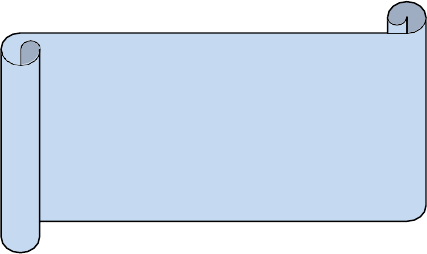
CAPP 1-2 01 October 2021
45
b. Supplements – auxiliary publications that augment CAP regulations. They cannot stand
alone; rather they must be linked to the parent regulation. Supplements are approved
by the NHQ office of primary responsibility (OPR) for the parent regulation, issued by a
commander at any level (unless prohibited by the regulation), and applicable to all
members of the issuing headquarters and their subordinate units. A template for
producing supplements is found on the CAP publications website.
c. Operating Instructions – publications
that mandate procedures or actions of
a local nature within one unit (charter
number) or office. Operating
Instructions (OIs) are approved by the
NHQ office of primary responsibility
(OPR) for the subject matter, issued by
a commander at any level (unless
prohibited by a regulation pertaining to the matter), and applicable to all members
within the chartered unit. OIs may stand alone and do not require a parent regulation. A
template for producing OIs is found on the CAP publications website.
All directive publications require an annual review to ensure the publication is current, essential
and relevant. Supplement and OI reviews are recorded as annual certifications (see CAPR 1-2).
Since new commanders might not be aware of all supplements or OIs issued by their
predecessor, it is recommended that they review these publications and direct a re-certification
after assuming command. In the future, all supplements and OIs, to include approved waivers
to regulations, will be posted on the CAP publications website for all members to view.
Nondirective Publications. These publications live up to their name too. Just like the pamphlet
you’re reading now, nondirective publications are informative or “how to” in nature and often
provide suggested methods, techniques or best practices for maintaining compliance with
directive publications. Pamphlets are less structured than directive publications and may be
released at any level.
The pamphlet structure and writing style depends largely on the subject matter. In essence,
due to the informative or “how to” nature of pamphlets, these documents should formatted
and styled in a manner that best presents the information to the reader. The use of graphics,
tables, flowcharts and colored text is highly encouraged to enhance readability and
comprehension. A template for producing pamphlets is available on the CAP publications
website.
Forms, Certificates and Visual Aids…Oh My! Okay, tests and controlled material are included
in this discussion too. Of these documents, forms are the most structured and, in accordance
with CAPR 1-2, their use must be prescribed in a regulation, supplement or Operating
Instruction. Historically, forms, certificates, visual aids, tests and controlled material have
collectively been kept separate from the traditional multi-page documents like regulations,
“The problem is that agencies
sometimes lose sight of common
sense as they create regulations.”
Fred Thompson
CAPP 1-2 01 October 2021
46
supplements and OIs. Unique to the formerly mentioned items is that they usually have
CAPP 1-2 01 October 2021
47
discreet development or handling rules, and oddly enough, some can fall into both directive
and nondirective categories of publications. For example, a directive might require the use of a
specific form; therefore the form could be viewed as directive in nature.
Some of these documents may be produced locally; however, several are available only from
National Headquarters as indicated in the Index 0-2, Numerical Index of Regulations, Manuals,
Pamphlets and Visual Aids, and the Index 0-9, Numerical Index of CAP Forms, Test Material, and
Certificates. The indexes indicate which documents are available online and which are
requested through the OPR or by using the Material Orders web page in eServices. Here’s a
summary of each:
a. Forms. By definition, forms are tools used for the collection, recording, and/or
extraction of information whereby a predetermined set of data fields have been
established and defined to meet a definitive CAP purpose or objective.
b. Certificates. These documents may be issued by any headquarters. Certificates are used
to recognize individuals or teams for a specific accomplishment, such as completing a
course of instruction or an “ataboy” for a job well done that doesn’t meet the threshold
for a decoration or award. Certificates issued by National Headquarters are standardized
in appearance.
c. Visual Aids. These documents succinctly capture guidance found in directive and
nondirective publications. They may also be used to summarize confusing information or
information found in multiple publications. An example of a Visual Aid is the Cadet Super
Chart, a poster that lists all requirements to attain milestones and awards in the cadet
program.
d. Test. Tests are a form of controlled material, even though they may be both open- and
closed-book. Tests are used to validate comprehension and application of material
necessary to complete a milestone or course objective. Tests may not be reproduced
locally without the express permission of the National Headquarters office of primary
responsibility (refer to CAPR 1-2 for more information).
e. Controlled Material. Documents and information are placed in the Controlled Material
category when the information is sensitive, not suitable for public consumption, or is
directed to be controlled by higher authority. In other words, information that’s released
on a need to know basis. Examples of Controlled Material include tests and CAP’s
assigned radio frequencies.
I NEED APPROVAL?? THE SECRET TO GOOD STAFF WORK
Much of CAP’s daily mission-related affairs require approval prior to taking action. The Web
Mission Information Reporting System, or WMIRS for short, automates the approval process.
But what if you needed approval for something that’s not covered in WMIRS? Approvals for
waivers, publications or special activities are examples of such actions requiring approval that
reside outside WMIRS’ capabilities.
CAPP 1-2 01 October 2021
48
The Electronic Staff Summary Sheet (eSSS) is the tool to get the information to the right people
for coordination and approval. It’s “electronic” in that it’s often sent as the body of an email as
opposed to an actual form. It gets its name from our Air Force partners. Since many of our
initiatives require Air Force endorsement, coordination or approval, it’s only natural that our
process meshes with that of our parent organization.
Originators need to understand that securing approval is all about marketing and how well you
sell your proposal. The following are secrets to help get the approval you seek:
a. Get the right people involved. Too many times these “staff packages” fail or stall
because the originator forgot to include a key player in the coordination process. Those
with approval authority are quick to pick out these key players in the coordination chain.
If their name is not present, the staff package will likely be returned or delayed until
such coordination is received. Ultimately, it’s a poor reflection on you, the originator.
b. Don’t involve the wrong people. The opposite of getting the right people involved is
creating a coordination chain that involves too many people. You guessed it – everyone
included in the coordination chain has an opportunity to comment…and they will. As a
rule, include only individuals who play a direct role in the proposal, people like the lead
subject matter expert(s) and your chain of command.
c. Be succinct and to the point. Nobody likes a longwinded email. The eSSS is no different;
remember the second “S” is for summary. A good technique is to imagine yourself as
the approving official. If you were handed the proposal, what questions would you ask?
What information would you need to make a sound decision? What do others think of
the proposal? That’s what you need to capture in the eSSS.
d. Set a realistic suspense (due date). Contrary to popular belief, most people don’t sit
around waiting for your eSSS to hit their inbox. They all have their own projects and
daily fires that they’re trying to extinguish. Like the old saying goes, poor planning on
your part doesn’t make an emergency for others (or something along those lines).
Okay, another old saying…junk in equals junk out. Bottom line is you’ll get better quality
feedback if you give coordinating and approving officials ample time to review your
proposal.
e. Leave your emotions at the door. The most effective proposals are those based on fact,
logical rationale and likely impact should your proposal be accepted. Inserting emotions
could be perceived as whining, that or you’re too close to the situation to make a
reasonable argument. The end result is that your proposal is likely to receive an
overabundance of scrutiny.
f. Buy-In is Important. Frame your proposal in such a manner that the likelihood of a
nonconcurrence is eliminated. While that’s not always possible, prepare yourself for
the fact that approving authorities really like it when everyone is in agreement. That’s

CAPP 1-2 01 October 2021
49
not to say your proposal won’t be approved if there’s a nonconcurrence, only that you
might have to better articulate your argument.
Electronic Staff Summary Sheet (eSSS). The eSSS loosely mirrors the content of the AF Form
1768, Staff Summary Sheet. Even though the Air Force has a form to document the
coordination/approval process, they too have a tendency to complete staff work via email,
hence the eSSS.
The eSSS has seven major elements: subject and date, coordination/approval chain,
originator’s information, suspense date, body or summary, signature block, and the tabs. Each
element is detailed below.
Subject and Date Element. Since we’re talking about the eSSS, the subject is nothing more
than the subject of the email. The same guidelines used in the memorandum and business
style letters apply here. By standard convention, the subject starts with “eSSS” followed by a
title that reflects the contents of the proposal. A suspense date normally follows the subject.
For example, “eSSS FY15 Appropriated Budget (Suspense: 1 Jul 15).” The eSSS date is the date
the email is sent.
Coordination and Approval Chain Element. The chain makes up the top of the eSSS and varies
with the nature of each request. It consists of those providing coordination, approval, and any
action caused by the decision. Routine actions, such as seeking approval for a publication,
typically have the same chain. It’s also possible for some activities to have multiple rounds of
coordination. For example, regulation revisions might see a round to coordinate inputs from
subject matter experts and a second round to coordinate inputs from CAP senior leaders and
secure CAP/CC approval.
The coordination and approval chain element identifies individuals (or their office) by unit and
organization symbol, and the desired action. Individuals performing the desired action
annotate completion by typing their last name, CAP grade, date and result of their action.
Oftentimes, coordination and approval are recorded in the email thread and not necessarily by
typing one’s name next to their respective line in the chain. Read replies and forwards
carefully.
Here are some examples of common desired action and possible results of those actions:
Common Desired Actions
Coord – means to review and comment, if needed
Approve – means just that. It’s conceivable that some actions require multiple
approvals, such as both CAP-USAF/CC and CAP/CC. If so, annotate this dual
approval accordingly.
Sign – used if the desired action is to have the approving authority sign
something
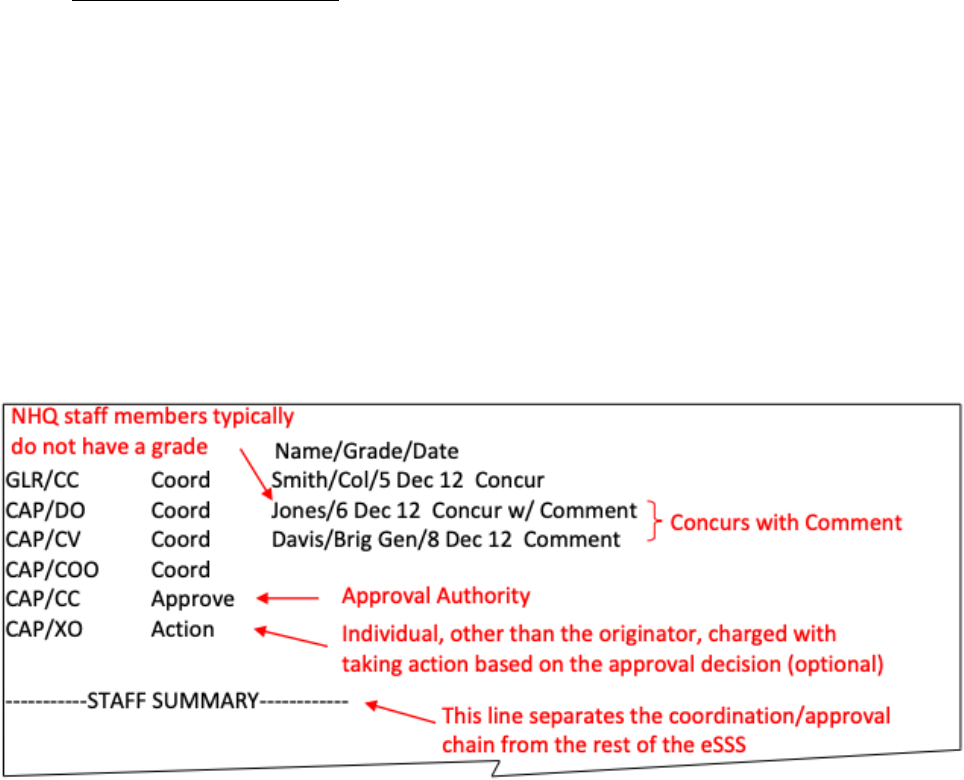
CAPP 1-2 01 October 2021
50
Action – signifies the individual charged with acting on the approval authority’s
decision. Action, when used, is typically assigned to a person not the
originator. For example, a proposal that requires the contributions of
multiple functional areas might assign the Chief of Staff in the Action line.
Common Results of Actions
Concur – means that the reader agrees with everything as presented and has no
comments to add.
Concur with Comment – a remark used when the coordinating individual agrees,
but has comments that may improve the proposal or add clarity.
Sometimes “Concur with Comment” is shortened to simply say
“Comment.”
Nonconcur – means that the reader does not agree with the proposal as written
Approved or Disapproved – a decision rendered by the approval authority
Here’s how an eSSS coordination and approval chain element might appear:
The coordination and approval chain follows a logical hierarchy, beginning with coordinating
officials and terminating with the approval authority. In rare cases, you’ll see an action official
listed last. When coordinating officials are from the same peer group, you can list officials
alphabetically or by using a commonly accepted convention. As a rule of thumb, the hierarchy
should look similar to a chain of command (peer groups listed in parentheses):
Squadrons (list numerically or alphabetically if squadron names are spelled out)
Groups (list numerically)
Wings (list alphabetically)
Regions (list by historical order – NER, MER, GLR, SER, NCR, SWR, RMR, PCR)

CAPP 1-2 01 October 2021
51
NHQ staff (list in order of significance to the subject matter or alphabetically)
CAP/COO
CAP-USAF/CC
CAP/CC
The Originator’s Information Element. The originator’s information is optional. This
information is usually included when the point of contact for the subject matter is not the
person releasing the eSSS. For example, the wing standardization and evaluation officer is
making a proposal and wants the wing commander to release the eSSS for more impact. The
intent is to provide contact information for the originator so the wing commander doesn’t have
to field a lot of questions.
The originator’s information takes the form of “AO” (short for action officer) or “POC” (short for
point of contact) followed by the originator’s grade, name, CAP, and contact number. The
information is provided immediately below the “------------STAFF SUMMARY------------” line as
shown below.
Suspense Date Element. The suspense date is simply the due date. Originators indicate the
suspense below their information as indicated above.
The eSSS Body Element. The body element is the heart of the eSSS and begins on the second
line below the suspense date. Paragraphs are numbered. The body consists of the following
sections, each being spelled in all capital letters so they stand out:
a. PURPOSE. The purpose is the summary of what you’re seeking to accomplish. It is
typically no longer than one or two lines.
b. BACKGROUND. The optional background highlights what has happened to compel the
need for your proposal.
c. DISCUSSION. The discussion is your argument; why someone should accept your
proposal.
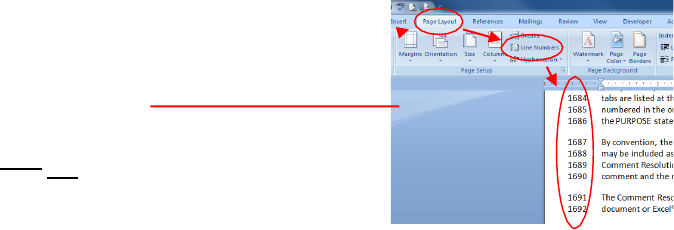
CAPP 1-2 01 October 2021
52
d. VIEWS OF OTHERS. This optional section presents opposing views or different
approaches to solving your problem. Sometimes views of others can be shown in a tab.
For example, when coordinating a publication, the views of others are the comments
received using the Comments Resolution Matrix (one of your tabs).
e. RECOMMENDATION. What is it that you really want? Spell it out succinctly in the one
to two-line recommendation statement.
The eSSS Signature Block. The eSSS signature block is the same used in the memorandum style
email, located at the left margin on the fifth line below the last line of text in the eSSS body.
The eSSS Tabs. Tabs are nothing more than attachments. Tabs are identified in the body of an
eSSS just like you would a reference to an attachment. Like the memorandum style email, the
tabs are listed at the left margin on the second line below the signature block. Tabs are
numbered in the order they’re presented in the eSSS, with Tab 1 normally being referenced in
the PURPOSE statement.
By convention, the primary document is Tab 1 (for example, the letter to be signed). Other tabs
may be included as supporting documents. As a minimum, one of the tabs should be the
Comment Resolution Matrix listing all comments received, the acceptance or rejection of the
comment and the rationale for the decision.
The Comment Resolution Matrix, or CRM for short, usually takes the form of a Microsoft Word®
document or Excel® spreadsheet. The CRM typically lists the following entries:
a. The contributor of the comment, identified by office, such as GLR/CC.
b. The type of comment:
1) C – Critical (contentious issue that will cause nonconcurrence with proposal)
2) M – Major (incorrect material that may cause nonconcurrence with proposal)
3) S – Substantive (factually incorrect material)
4) A – Administrative (grammar, punctuation, style, etc.)
c. The page number as reference.
d. The paragraph number or title as reference.
e. The line number, if used, as reference.
f. The comment to be addressed. For example, “change to
read: ‘The quick brown faux fox jumped over the lazy dog.’”
g. The rationale for the comment. For example, “proper word
use.”
h. The OPR’s decision to accept, reject or modify (A/R/M) the recommended comment,
with rationale for nonconcurrence or modification.
An example of a CRM entry is shown at the top of the next page.
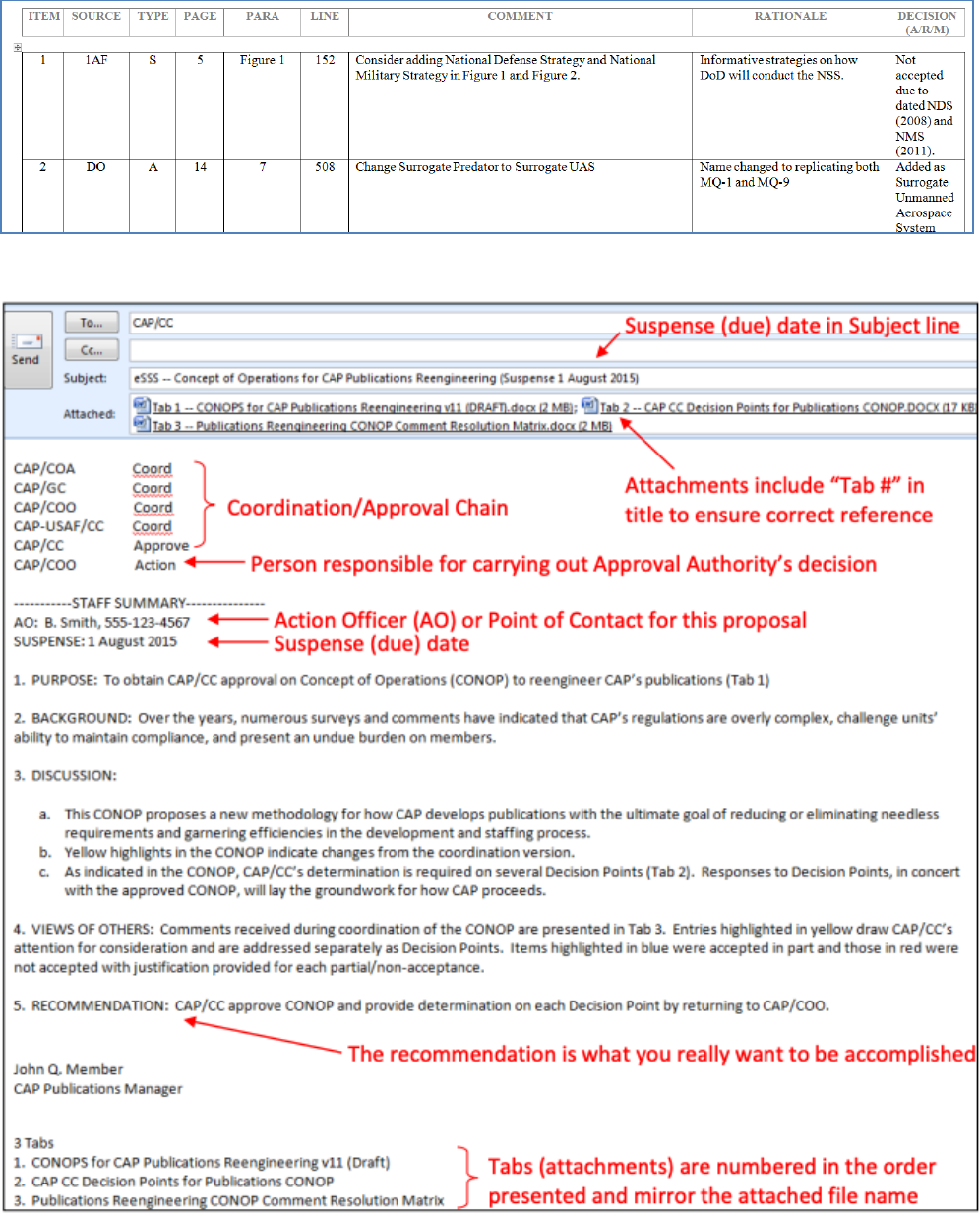
CAPP 1-2 01 October 2021
53
Putting it all together, an eSSS might look like the example shown here.
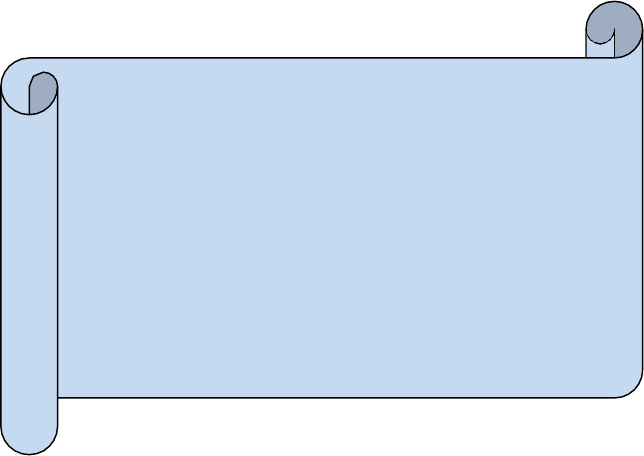
CAPP 1-2 01 October 2021
54
CONCLUSION
That’s it. Everything you need to know to be an effective communicator in CAP. Okay, that’s
not true, but at least you now have an understanding of things to consider when conducting a
meeting, how to prepare yourself for public speaking, how to craft an effective and professional
memorandum or business style letter, not to mention a number of other documents, and how
to wrap it all up in a nice eSSS to get approval.
So stop reading and get to work…
“I like nonsense; it wakes up the brain
cells. Fantasy is a necessary ingredient
in living; it’s a way of looking at life
through the wrong end of a telescope.
Which is what I do, and that enables you
to laugh at life’s realities.”
Dr. Seuss
